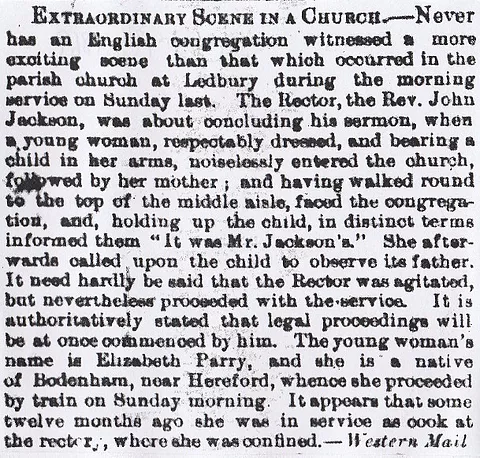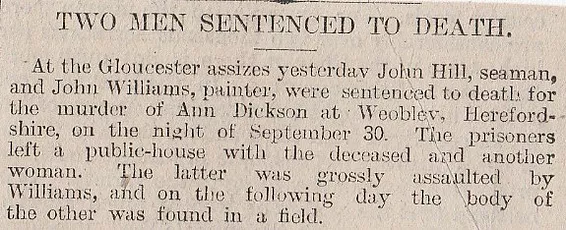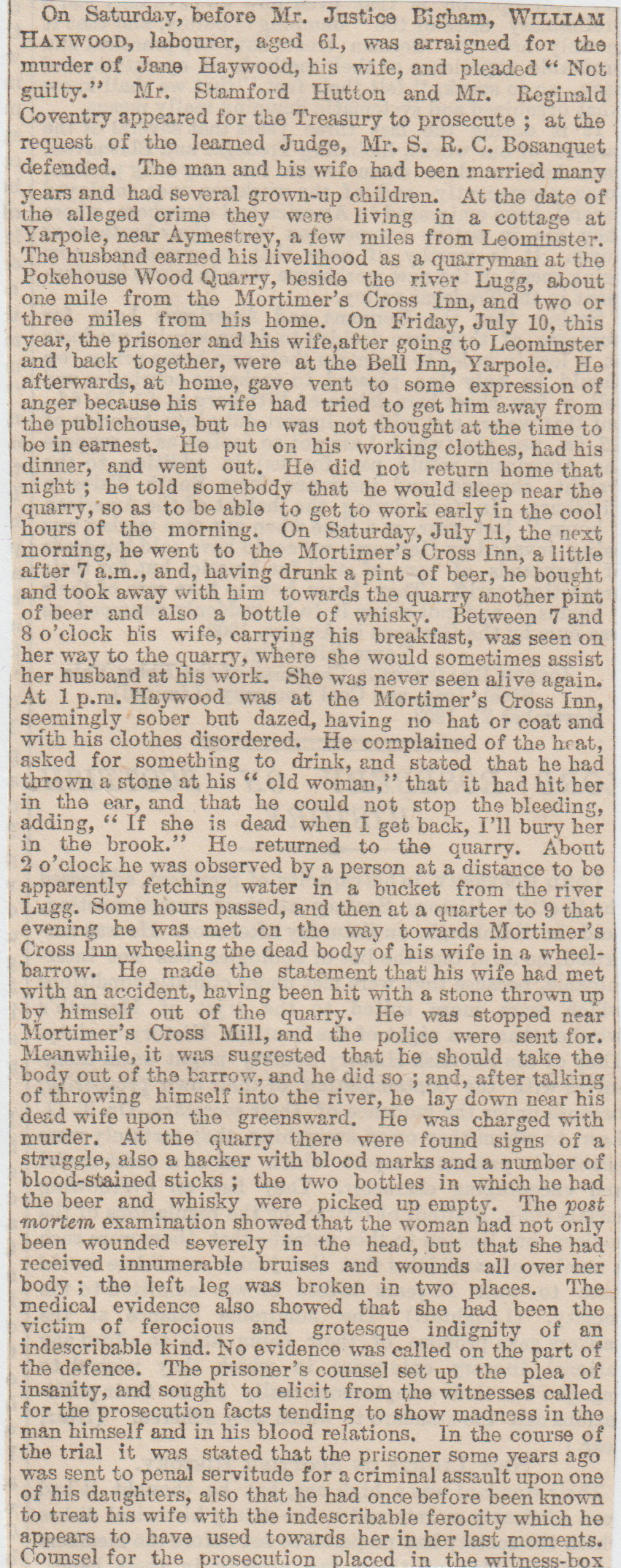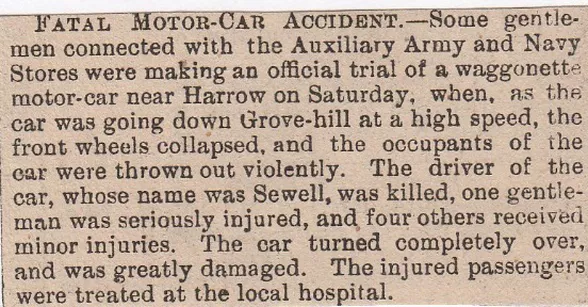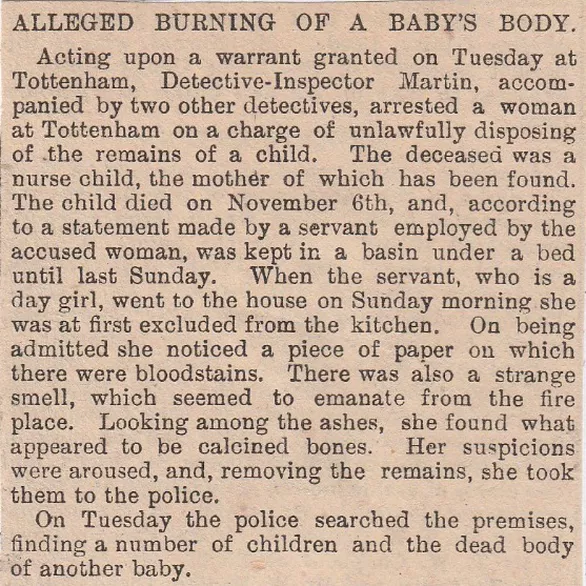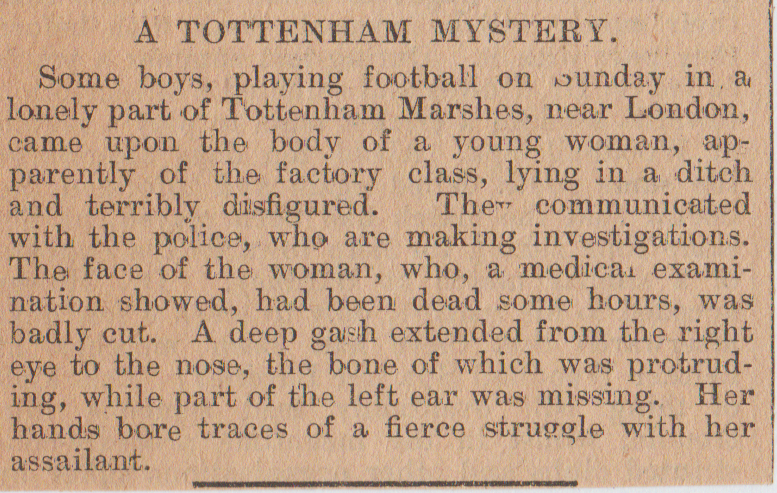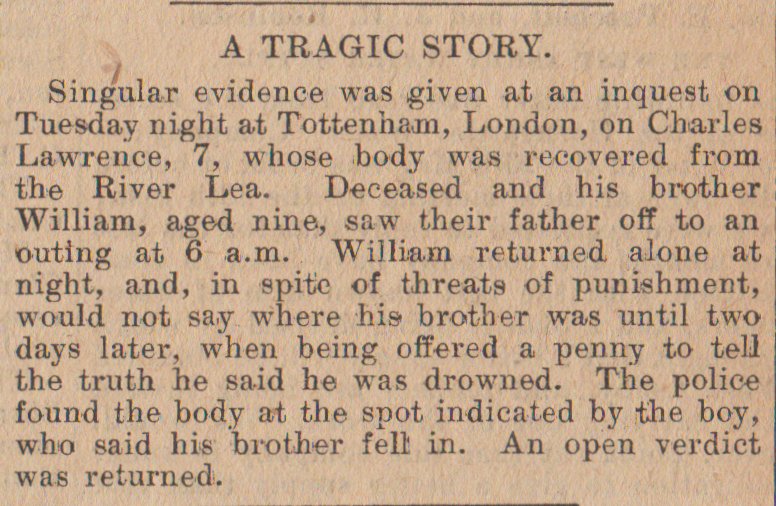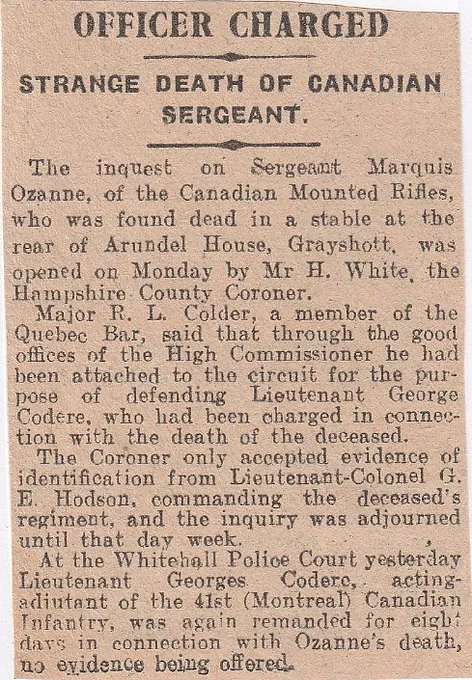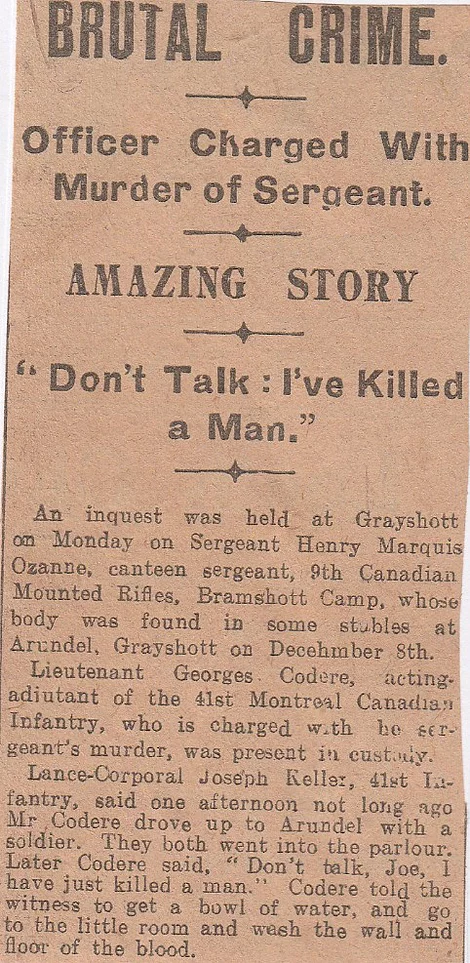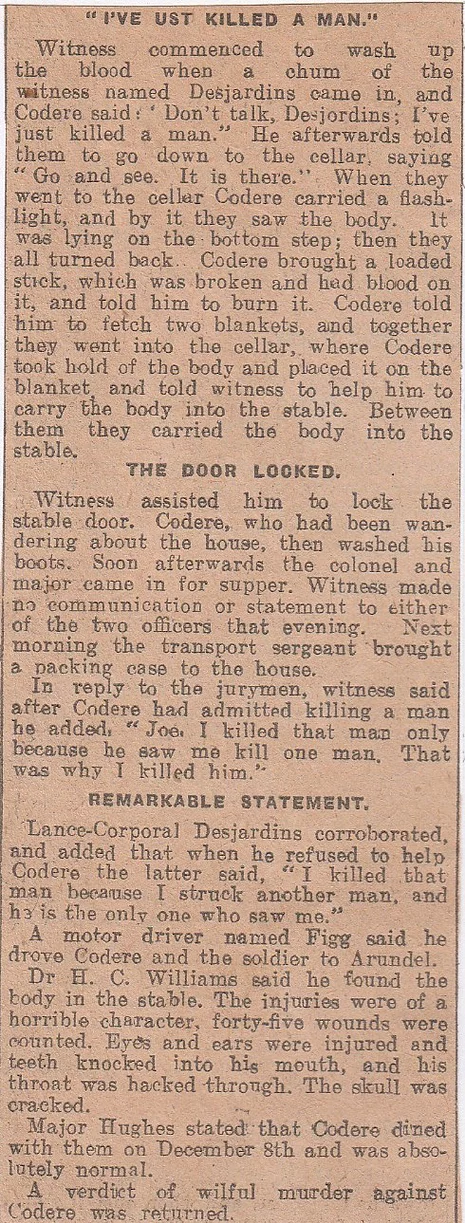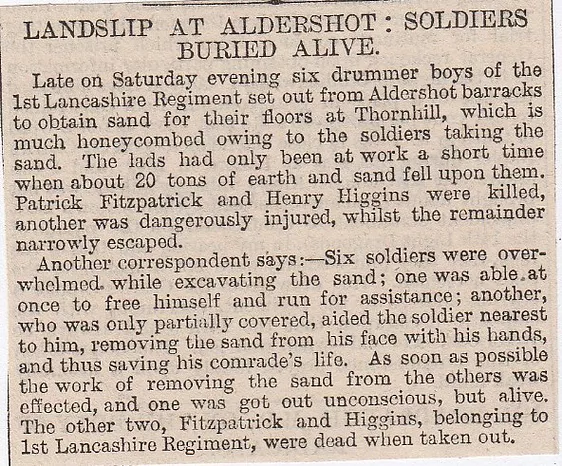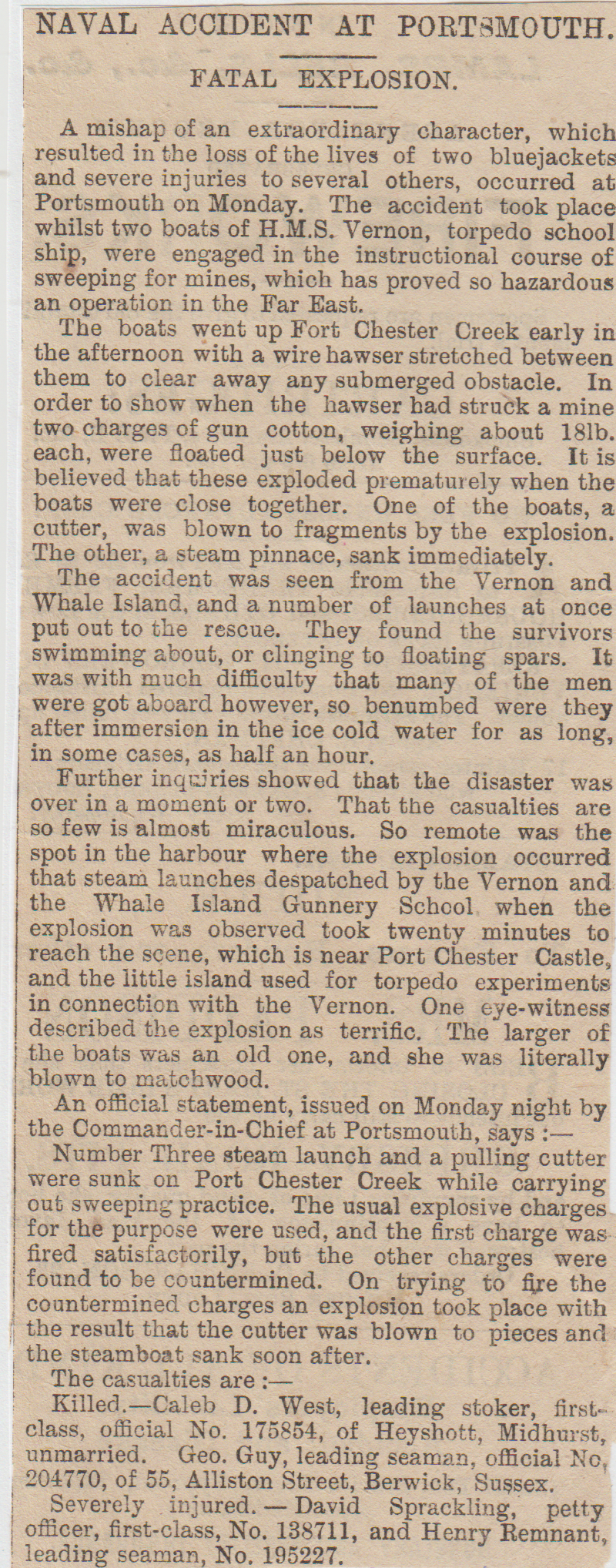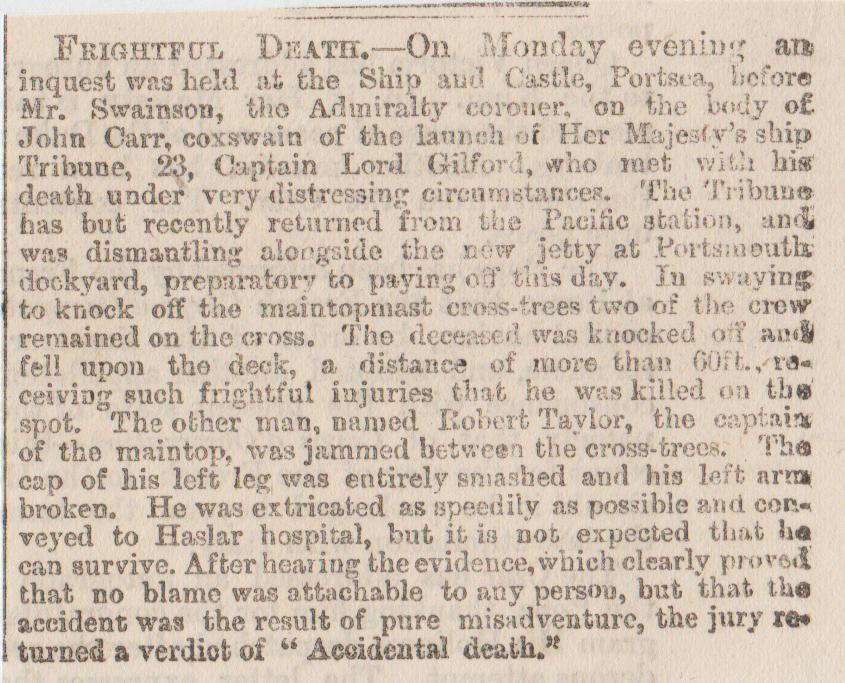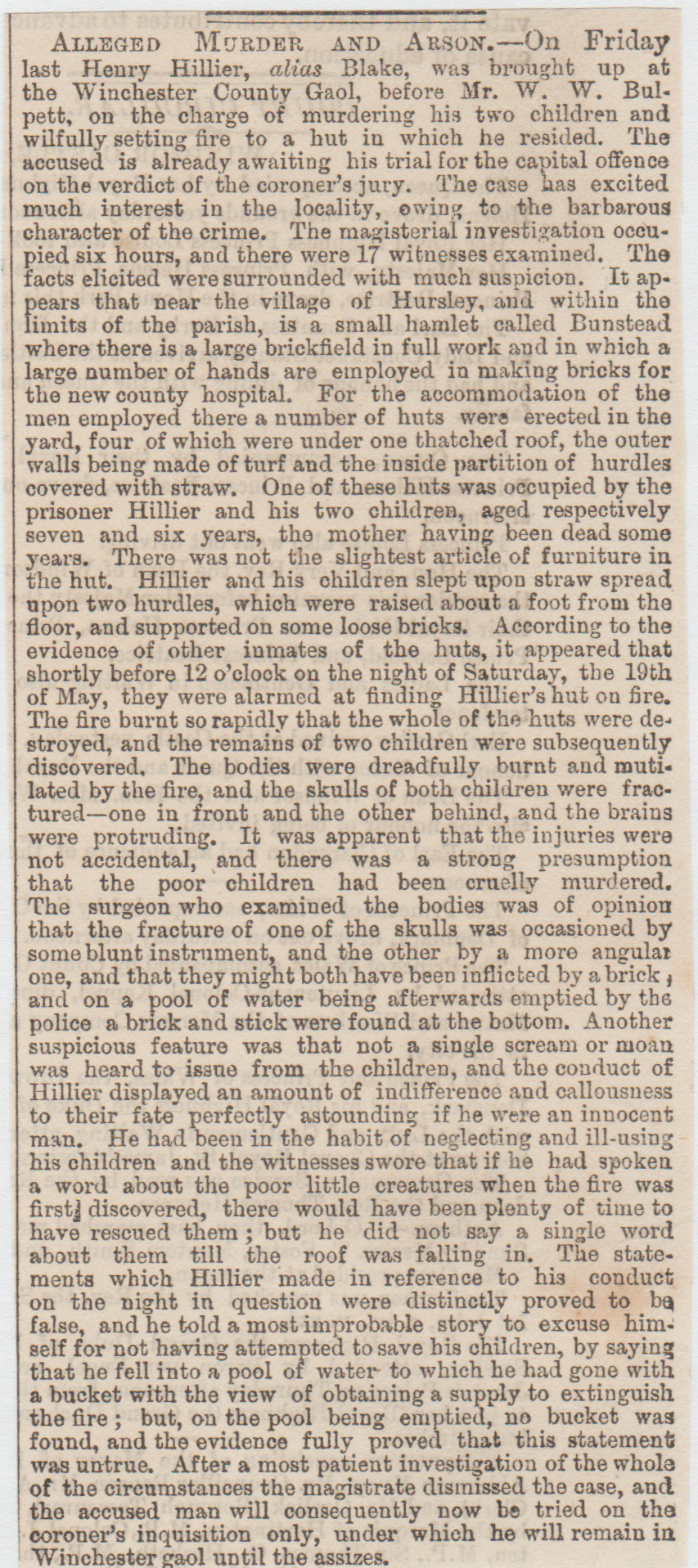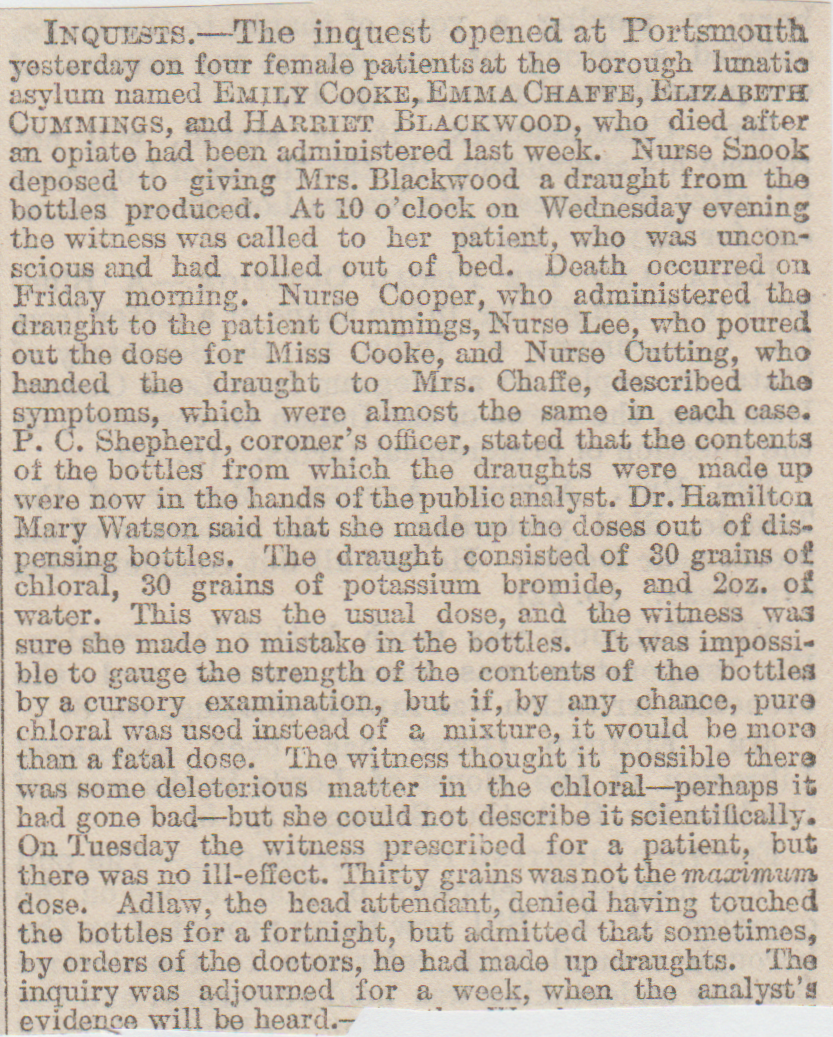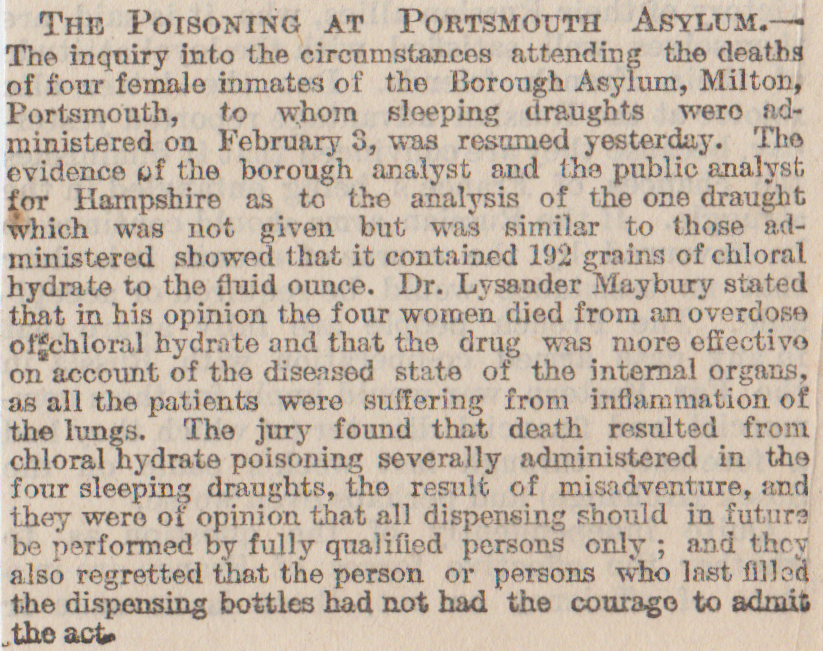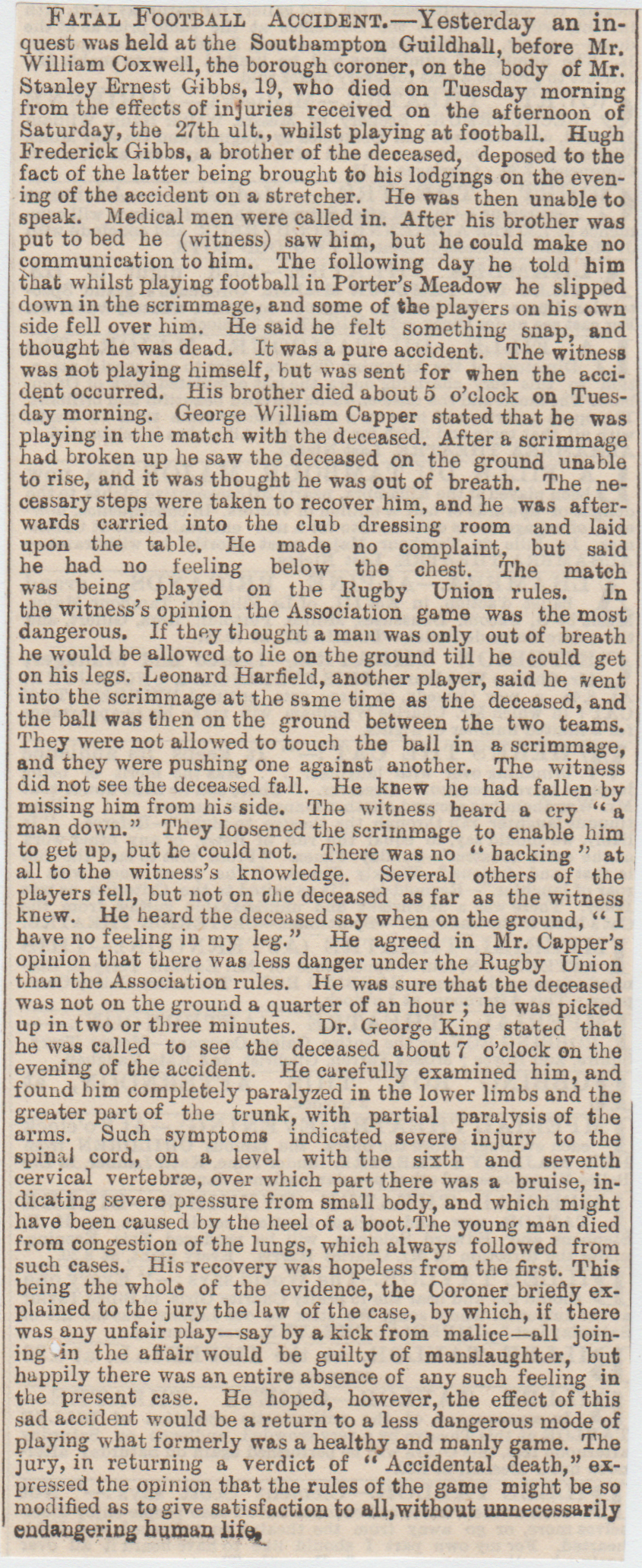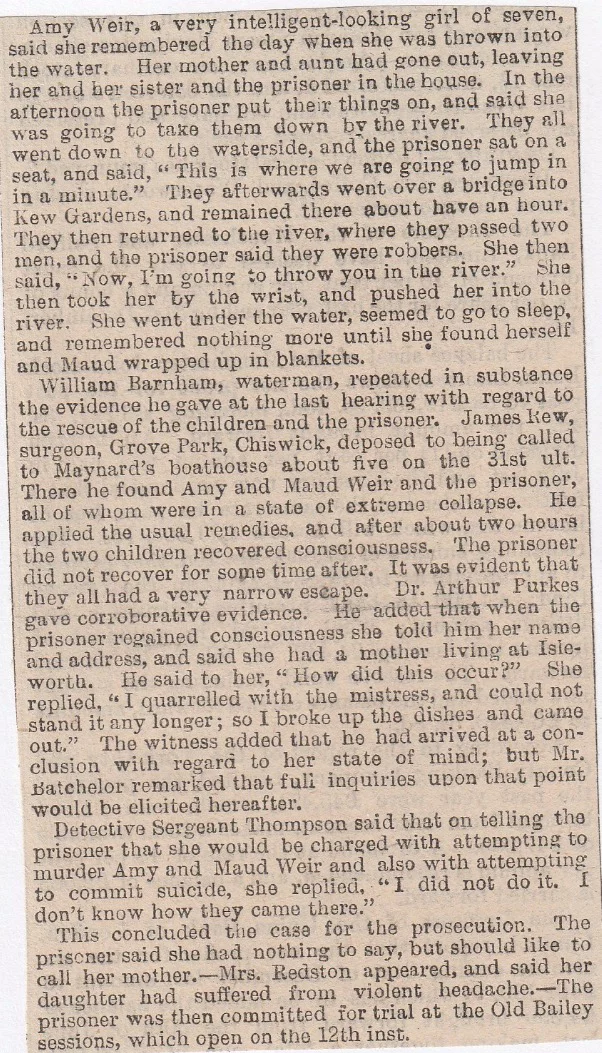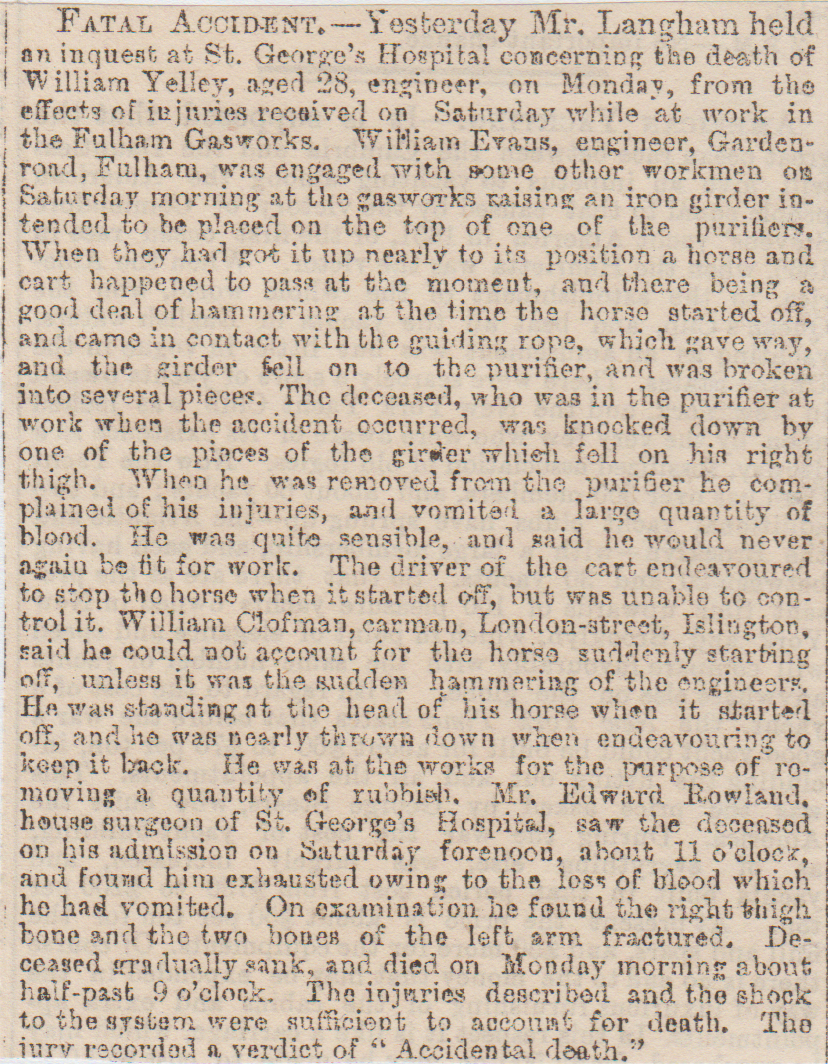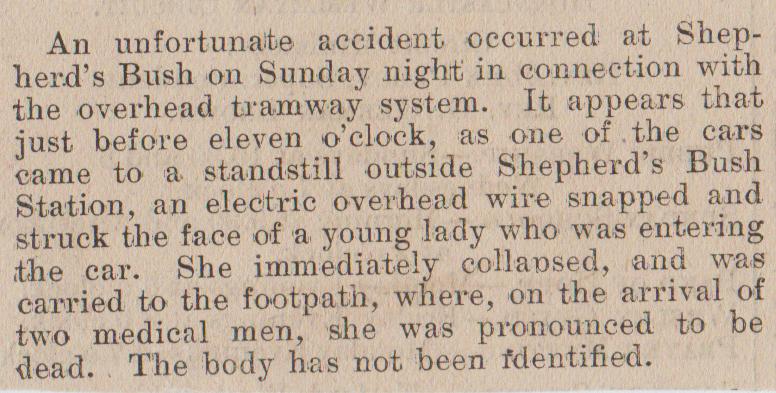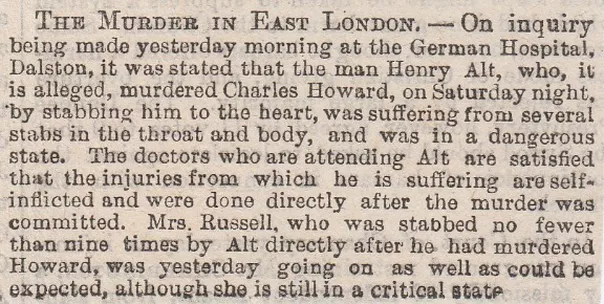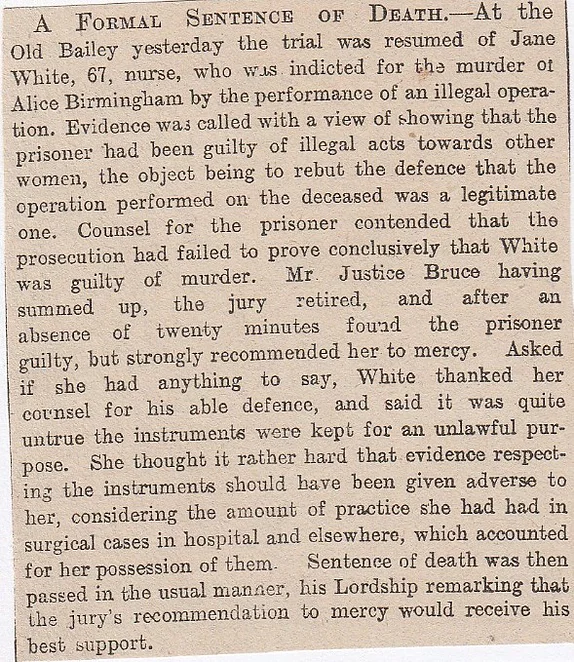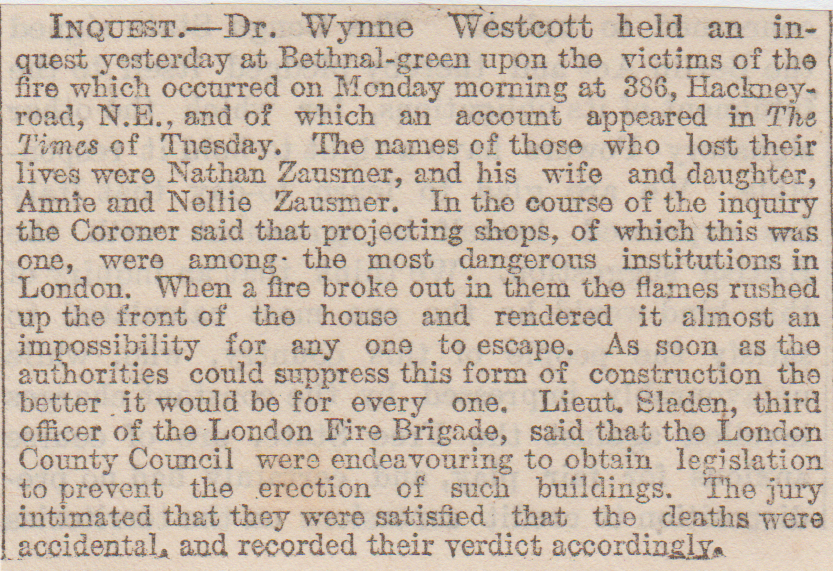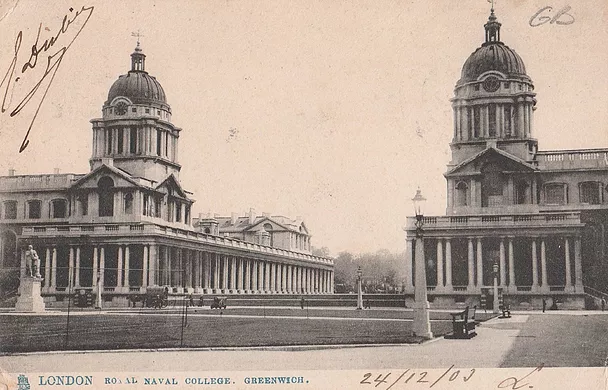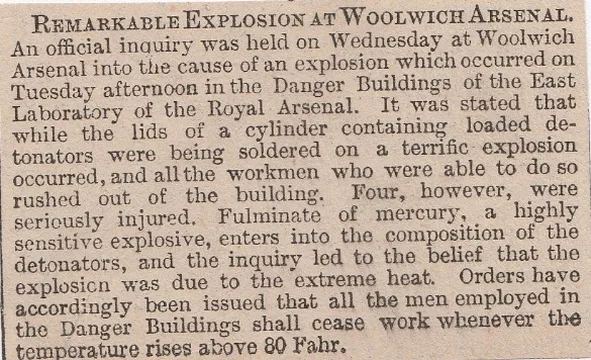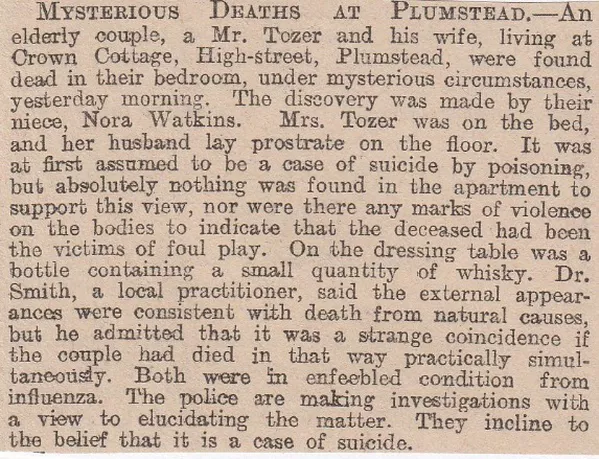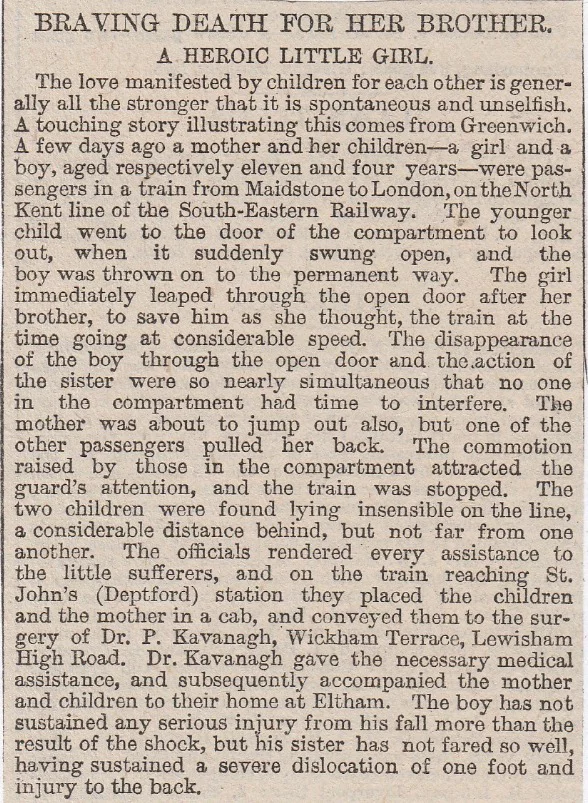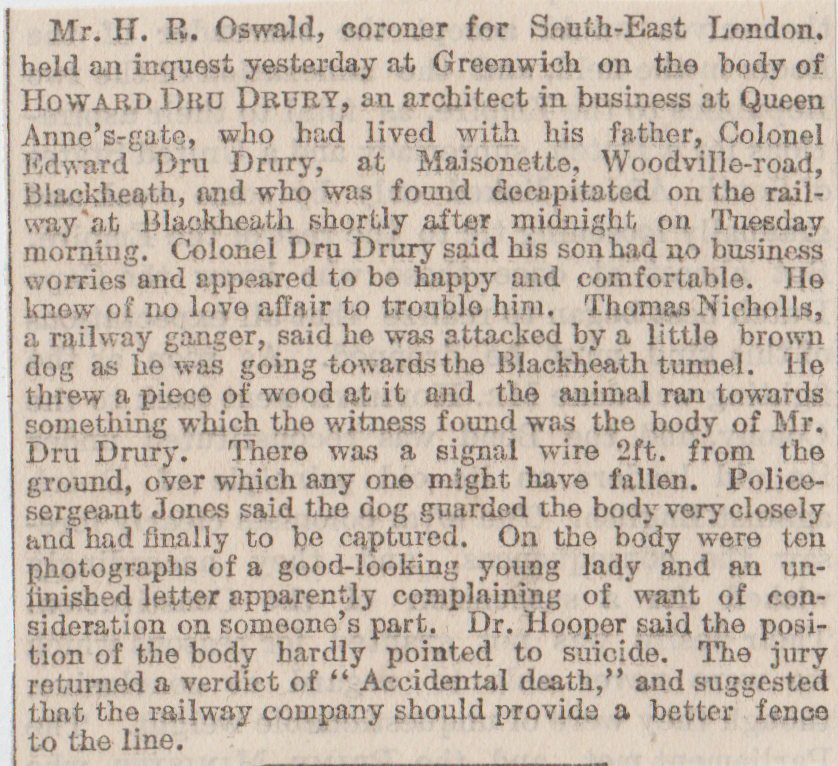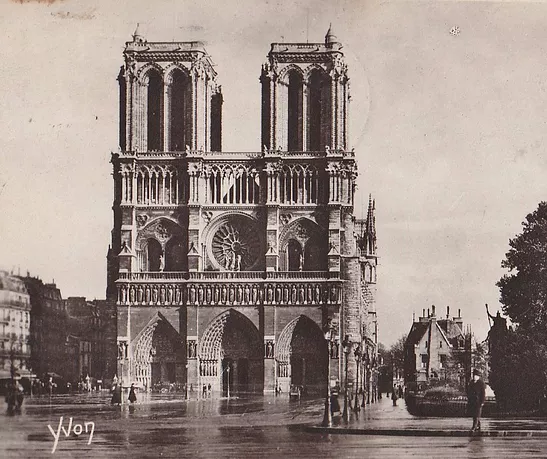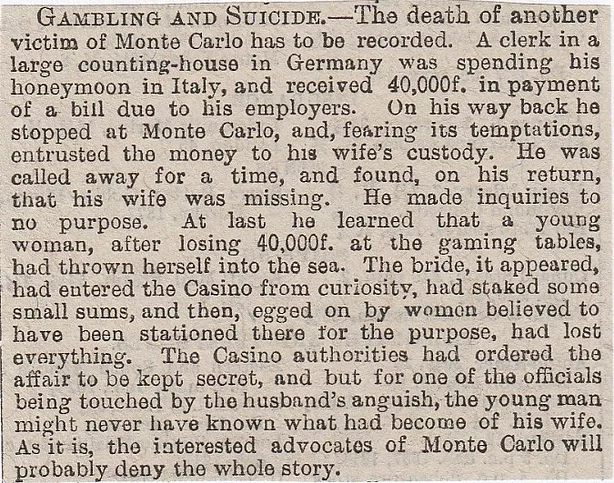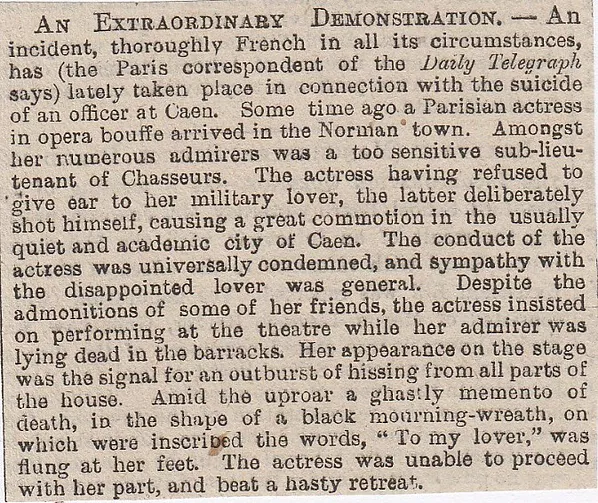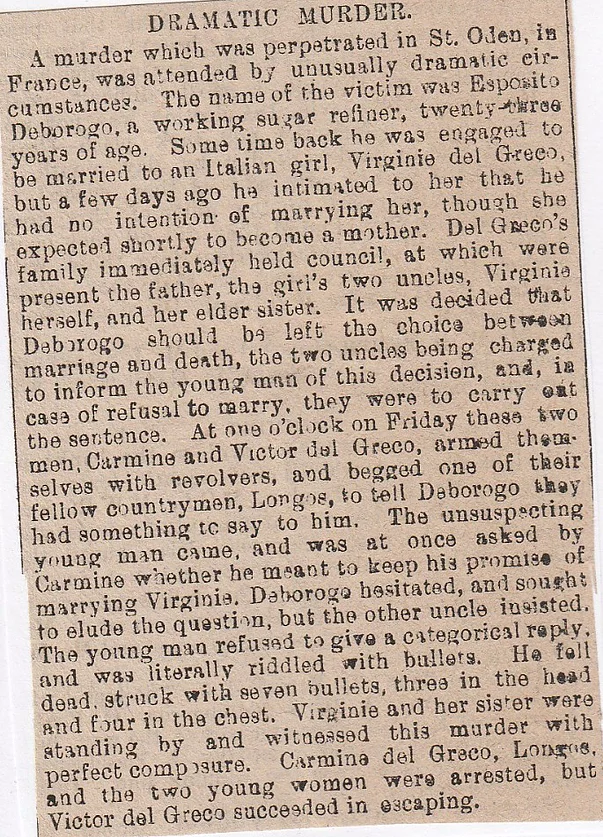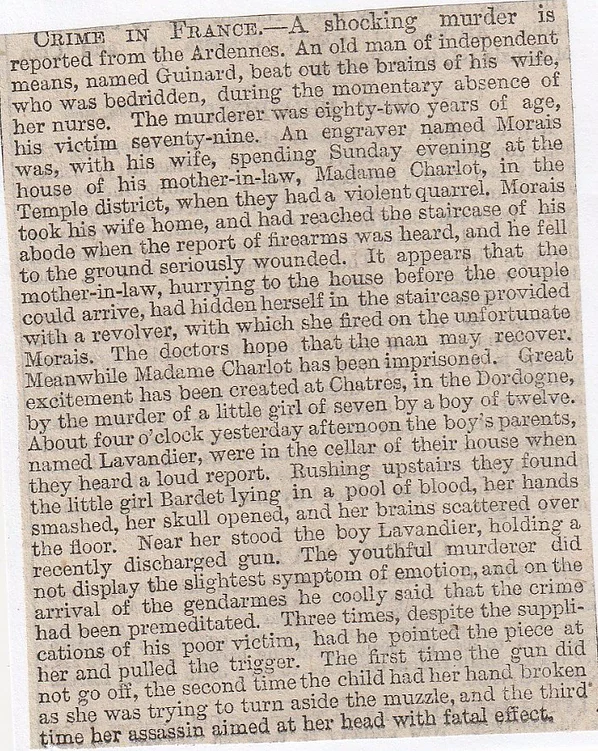1/ Blundell Park Death? January 1889
William Cropper the Derbyshire professional cricketer, while playing in a game of football at Grimsby on Saturday for Staveley against Grimsby Town, was accidentally kicked in the stomach by a half-back Daniel Doyle and was stretchered off. He died the following day of his injuries. The game was said to have been of a rough nature throughout the entire game.
2/ Freeman Street (Child Fatality) January 1884
On Saturday afternoon a six-year-old boy named William Clark, the son of Mr William Clark of No.33, East Marsh Street was running across Freeman Street near to East Marsh Street when he slipped and fell. One of Mr Hamer’s beer-carts was coming along at the time and before the driver could stop, one of the wheel’s passed over the boys back. He was carried home and a doctor was summoned, but he died within a few minutes, just before the doctor had arrived.
3/ Extension Fish Dock, (Body Discovered) August 1892

4/ Grimsby Docks Station/Town Station Death, August 1905
The body of a Great Central goods guard was discovered in a badly mangled condition, between the Grimsby Town and Grimsby Docks Station. It is believed that he missed his stop and tried to jump off the train while it was in motion, then fell under the train and was crushed to death.
5/ No.21 Nelson Street Suicide, June 1878
John Parker, a fish-packer who lived at 21, Nelson Street, killed himself by slitting his throat with a razor. He had been suffering from rheumatism for a while despite being only thirty-four years of age. His doctor had seen him one morning and he seemed in good spirits. His wife went up to his room when she heard him cry out and saw him standing in front of the mirror, staring at himself, with a razor in his hand and with blood oozing from his neck.
6/ Grimsby Docks Body, May 1884
This is a recurring theme of the Grimsby section of this website and that is bodies being found in the Docks, either accidents or suicides. The number of bodies that must have been fished out of there must be in the hundreds and if you’re a believer that people come back and haunt the scene of a tragic event, then the Docks would be smothered with ghostly activity.
One afternoon, as No 4 Dredger was working on the east side of the Fish Dock, a man saw something rise to the surface and it was dragged out. It was the body of a male around 30-ish, dark hair, but no whiskers. He was dressed in a sea-farers attire and it was thought it was the man who went missing from the Scarborough steam-trawler “Sequel” in February.
7/ Haycroft Drain? Suicide, September 1906

8/ GrimsbyWife Murder, (Starved to Death) October 1884
Charles Frederick Joseph Briggs and Elizabeth Briggs were charged with the wilful murder of Thirza Briggs, the wife of Charles, by starving her death. A relative of the Briggs’s said she visited them on several occasions and Thirza looking emaciated for the majority of those visits, also adding that Elizabeth Briggs acted like a tyrant towards her. She called a doctor to see her, when Charles refused her access to one. When she finally died the post-mortem revealed that died from “sheer starvation” (What happened to them both?/Where in Grimsby was this?)
9/ River Humber, (Four Drowned) February 1899
Four Grimsby men, Freer, Turner, Barr and Ball, went out in a boat on the River Humber to mend the Trinity House light on the sunken sloop,”Elizabeth”, which was proving to be hazardous to shipping in the area. They never returned and the vessel is presumed to have capsized. All the men drowned, with none of the bodies have yet been recovered.
10/ Grimsby, (Lighthouse Master Hangs Himself) October 1874
William Mudd, the master of the middle lighthouse stationed in the Humber, off Grimsby, killed himself by hanging with a necktie and a piece of cord which he attached to a tree branch near his home in Grimsby.(Where in Grimsby?)
11/ Hainton Avenue, (Youth Shot in Head) January 1916

Grimsby Railway Deaths (This section is littered with accidents/suicides/deaths)
12/ January 1863
The death of Sarah Parker which took place at the Cleethorpes Road Crossing. The deceased was warned by the gate-keeper at the crossing and her death was not the fault of him, but entirely her fault.
13/ Fishing Dock Crossing Death, August 1864
A fisherman named Manning was knocked over by a passing train and was killed outright, at the place known as Fishing Dock Crossing. The gateman saw him approaching when a train from Grimsby Dock Station to Cleethorpes. He was clearly drunk and the gateman kept shouting at him that a train was coming, but his view was blocked by a hoarding next to the line. The gates had been thrown across the road to let the engine pass and next to this is a wicket-gate for the use of pedestrians to cross, but as soon as he got through the gate the train smacked into him and he was run over his neck and feet by the wheels.
As you can see from this old postcard of the Dock Office at Grimsby (bottom of the flyover and across the road from the Telegraph Offices) there is only a feeble gate, with nothing else to prevent an accident.

14/ Grimsby? January 1869
John Woodward, who worked for the Manchester, Sheffield and Lincolnshire Railway Company, was shunting a goods train from New Holland. He gave the driver the signal to come back, then got under the waggons to uncouple them and on getting out he caught his foot and fell over. The train ran over him mangling him severely. He was rushed to Hospital where amputation of limbs would be the only way to save him, but his condition deteriorated and he died the next day.
15/ Grimsby Dock Station (Mutilated Corpse) July 1870 (This station is down Kent Street, off Freeman Street)
There wasn’t a great deal left of seven-year-old Charles Pepper, the son of a dock labourer, when they found his remains. The young lad was sent on an errand by his parents and crossed the railway line where there was no crossing and there he met his death. He had got tangled in the shunting waggons and was run over, with his mutilated remains being put in a sack and taken to the hospital for identification. He was clearly trespassing on the railway and is a common problem in the area.
16/ Pasture Street Crossing Fatality, December 1870
Frederick Cook, the son of George Cook, a labourer, residing in Queen Street, was trying to creep under some waggons while they were being shunted near Pasture Street crossing when the engine moved and several waggons ran over him.
17/ Grimsby Dock Station Fatality, August 1875

18/ Grimsby Town Station Corpse, November 1976
A post-mortem was carried out by a Home Office pathologist on the body of 68-year-old Hugh Lyons, who was a resident in St John’s Hospital in Lincoln. His body was found about ten yards from the Deansgate bridge near Grimsby Town Station and had been lying for some hours. How he came to be there is a complete mystery to everyone.
19/ Grimsby Town Station Fatality, January 1878
People who live in the Grimsby area will know the pub, the Cross Keys at Fulstow. It was the publican of this, John Hill, who was in Grimsby looking around the market and was due to return on the 4-40 to Louth. He missed his train and tried to get on another one, but this went to Cleethorpes and the porter dragged him away. Still believing it was his train to Louth he ran after it and tried to grab the handrail, but he was dragged along between the platform and train. He let go and the dummy carriage ran over him, causing terrible injuries and a near amputation of a leg. He was whisked off to hospital but died on the way there.
20/ Grimsby Town Station Death, June 1878
Thomas Spence, a guard who worked for the G.N.R. Company arrived at the Town Station at two p.m., when he complained of a pain in his head. He collapsed and was put in a waiting room nearby, then a doctor was sent for. Unfortunately, Spence died just after he was seeing to him. He lived in Boston, and he leaves a widow and children. (Sounds like a blood clot/brain haemorrhage)
21/ Docks Station Fatality, July 1884
A clerk for the M.S and L railway Company, 17-year-old George William Bee, was run down by a goods train at the Dock Station on a Saturday night and later on, died from the injuries he sustained. He jumped on the truck of a goods train and was told not to by a shunter on duty, but he carried on. The train was going at eight mph at the time, when he tried to jump off at the Docks Station but fell between the rails and the platform and his legs and feet were crushed by a train. He was taken to the hospital and amputation was the stark reality for the young man. He gradually grew worse and finally died from loss of blood and shock.
22/ Cleethorpe Road Railway Crossing July 1886

23/ Dock Offices, Grimsby, (Body on the Track) September 1902
Fred Dunn, an accountant residing at Cleethorpes Road in Grimsby, who was also the assistant secretary to the Grimsby and District Hospital, was knocked down by a train and was killed on the spot. He was walking on the tracks at the Dock Offices when he was run over and badly mangled under the wheels.
24/ Grimsby, (Train Suicide) February 1914
A young lass by the name of Frances Baumber who was visiting from Skegness, leapt in front of a train at Grimsby, causing her instant demise. A friend who was with her, Miss Broughton, tried to stop her from getting on the tracks but failed.
25/ No.287 Heneage Road (Flooded Subway Victim) March 1920

26/ Little Field Lane, Grimsby, (Child Remains) July 1859
An inquest was held on the body of an infant found in Little Field Lane, secreted in a drain tile. When discovered, it was so decomposed that it was impossible to determine the sex. The surgeon thought that it had been murdered but there were no clues left behind as to determine the identity of the perpetrator.
27/ Hope Street, Grimsby, (Fatal Stabbing) February 1903
A sentence of death was passed on Samuel Henry Smith, a Grimsby fisherman, for the murder of Lucy Margaret Lingard. The prisoner used to visit Lingard, who was married to another and on the 18th of November, 1902 they were out on a pub crawl. The two argued after consuming whisky and other spirits. He then completely lost the plot and stabbed her in the body, twelve times. She hung onto life for another twelve days, then expired at Grimsby Hospital.
28/ Grimsby Hospital, (Chimney Kills Patient) March 1895
At the childrens ward in Grimsby General Hospital, a chimney fell through the roof. One of the patient’s, a young boy named Revell, was killed on the spot.
29/ Royal Dock, Grimsby, July 1859
The body of a man by the name of Peter Wright Blanchard was found drowned in the Royal Dock. It is believed to have been accidental.
30/ Grimsby Town F.C. v Man City April 1899 (The last time these two clubs met?)
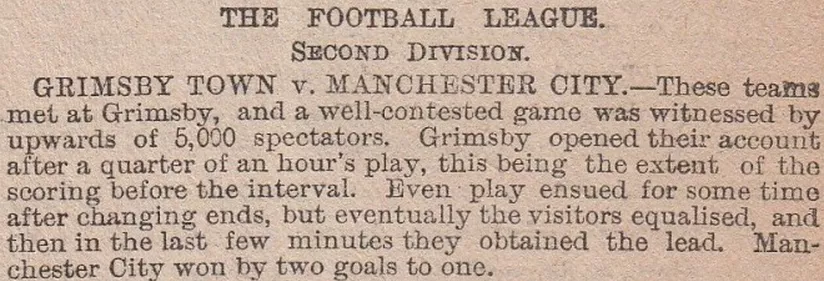
31/ Grimsby, (Destitute Man’s Suicide) July 1884
Samuel Preston, a confectioner at No.246 Victoria Street, was found hanging by the neck in his own house, quite dead. He was separated from his wife who now lived in Nottingham and who allowed him fifteen shillings a week to get by on. (Wife paying the husband?) Police found no food or cash in his house.
32/ Grimsby (Crushed By Gravestone) September 1916
Ten-year-old Hetty Holmes, while playing in the yard of a mason at Grimsby began to swing on a gravestone, weighing three-quarters of a ton, when it gave way and fell on top of the poor child. She was alive when pulled from underneath it, but her injuries both internal and external were so severe that expired within an hour.
33/ North Sea Murder, August 1889

34/ Scartho Road (Infants Body Found) October 1866
The body of a male infant was discovered in the bottom of a hedge on Scartho Road. Mrs Preston found the corpse at eight a.m. when she was picking brambles with her little boy. It was when she was near Nuns Farm when she saw the bundle wrapped up and at the base of the hedge next to the roadside. The surgeon said the child was full grown and had breathed and stated that he couldn’t account for the cause of its death. There were no marks of violence and it was badly decayed.
It was approximately a year ago (1865) since a similar discovery was made at Deans-gate, about half a mile away from the spot where this infant was found and it was also left at the bottom of a hedge.
35/ Lincoln Arms Death, January 1870
This was a pub situated at the top of Freeman Street and Cleethorpe Road, now demolished. James Feeney aged twenty-eight, a trimmer at the coal drop on Grimsby Docks, went into the Lincoln Arms already three sheets to the wind, then popped his head on a table in the taproom and rested. The landlord tried to wake him up but he was fast asleep. He put a pillow under his head and stoked up the fire, then went to bed and left him there. The next morning he found him in the same position. Checking if he was OK, he found no pulse. The verdict was “Apoplexy, brought on by accidental strangulation, produced by excessive drinking.”
36/ West Marsh Creek, August 1879 (Human Remains)
Human remains were found by workmen who were excavating for the new dock works near the old West Marsh Creek near the Smith Bros, shipbuilders yard. About two feet underground they stumbled on some human remains. They were buried in the usual way, face upwards, with the feet towards the water, on the bank of which they made the grisly discovery. As soon as it was exposed to the fresh air, it partially crumbled, but some bones remained firm enough to dig out. The skeleton is thought to be a female, but whether she died naturally or if she was murdered is difficult to ascertain. (Who was she?)
37/ Freeport Wharf, (Two Women Burnt to Death) July 1860

38/ County Court, Grimsby, April 1906 (John Barker’s Attempted Murder)
John Barker, solicitor and clerk of the peace, was shot at by a man against whom he had had occasion to appear. Barker was leaving the county court, when a man pointed a gun at him and screamed “You’ve ruined my life, I’ll ruin yours”, then discharged the gun twice. The first missed completely but the second grazed him and then thinking he had killed Barker, he then put the gun to his temple and pulled the trigger. He was identified as Isaac Swaby, a tailor. He survived the incident and told police afterwards that he did it while he was drunk.
39/ Old Dock, Grimsby, (Dredger Unearths Body) April 1880
While a dredger was being worked in the Old Dock at Grimsby, it brought to the surface the body of a man which was embedded in the mud. He was identified as Joseph Needham of East Marsh Street, who vanished in December 1879 and had never been seen since.
40/ Corporation Road Bridge Death, March 1880
One Thursday morning in March of 1880, a young lad was standing at the end of the Corporation Road Iron Swing Bridge, while it was open for the passage of ships up the Old Dock. When the bridge closed, the boy tried to cross it to soon and was crushed to death in the bridge. He was transported with all haste to a doctor’s nearby, but he was dead on arrival.

41/ The Ship Inn, Flottergate, Grimsby, May 1863
On April the 30th 1863, the Ship Inn at Grimsby on Flottergate was the scene of an inquest into the death of Sophia Ward, who died the previous evening. She was adjudged to have died from heart disease while chatting with a neighbour on her way home. That is not really a story in itself, but the very next day the landlord of the Ship Inn was discovered by his missus dead in bed. Mr George Warburton had been ill for several days, but not exactly racked with pain. Apparently, this was the second landlord to drop dead in his pub in the past few days. The landlord of the Lord Nelson, Mr Henry Hobson also died on his premises. ( I found out it was 208, Victoria Street). Dropping like flies around that time, in that area.
42/ Freeman Street/Berlin (Firing Squad) September 1914
In some ways a rather gruesome story, but on the other hand, it could be perceived as one of stoic stubbornness from a Teutonic immigrant. Albert Kiesel was a jeweller in Freeman Street and was of German origin, so when he retired he went to Berlin to see out his latter years. The Landsturm (German equivalent to military reserves) called him up, but he said that he wouldn’t join as he had friends in Britain, plus he was firmly against any sort of military action against them. He was then taken out and faced the firing squad, while Mrs Kiesel watched on. She also had the indignity of having her property and assets confiscated by the state. Mrs Kiesel made her way to England, to find refuge with former friends. (Did she come back to Grimsby?)
43/ Grimsby (Drunken Suicide) July 1907
Charlotte Howson killed herself in a bizarre fashion whilst she and her husband were getting plastered. She suddenly raised her glass in the air and shouted “This is the last drink I shall ever have!” then gulped it down. She told him that she had laced her beer with laudanum. Then a doctor was quickly fetched, but it was too late for Charlotte, as she died there and then. (Where was it?)
44/ Wood Street August 1877 (Somnambulist/Child Cruelty?)

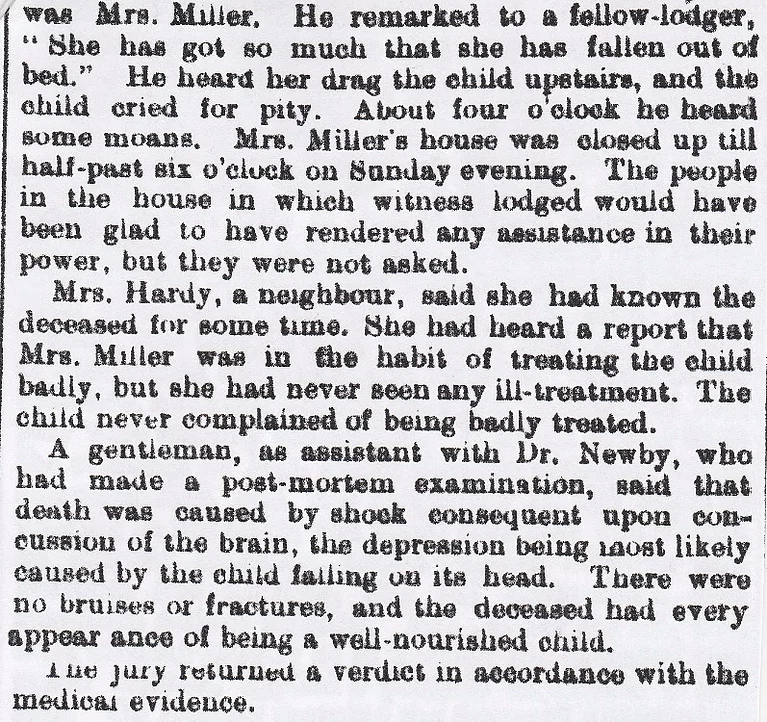
45/ Garibaldi Street Suicide, August 1877
21-year-old grocer, Henry Joseph Portugal Hazwell living down Garibaldi Street was found dead in his bed. By the side of the bed were two packets of “Battle Vermin Killer”, from Jepson’s chemists down Freeman Street, along with a bottle of gin. A number of letters were found, one addressed to the Coroner. It read: “Sir- I have committed this rash act myself by taking poison- yours respectfully, H.J.P.Hazwell”. One of the others was addressed to Miss Cooper,No. 3, Garibaldi Street, it read:
“My dear Katie- Through your deceitfulness and non-confidence in me, I am about to commit a very rash act. I forgive you of all the harm you have done to me. I hope the next lover you have will care as much for you as I have. He can’t love you better. I enclose in this letter my two rings, hoping you will forever keep them in remembrance of me. This is wrote before seven in the morning. As you do not love me and you make it appear impossible for us two to be joined together, I commit this rash act on myself, afraid I should take your life. I have often thought of it. But I forgive you everything and hope that the Lord will give you a true heart, which you have not now. So I must conclude. May the Lord have mercy upon my soul. O Lord have mercy upon me. O Christ have mercy upon me. O! Lord receive my spirit into thine everlasting Kingdom for Christ’s sake. Amen. From your loving Harry- H.J.P.Hazwell. And may the Lord guide your footsteps in the right way for Christ’s sake. Amen.
In the others, he tells his sister that she can have his watch and chain and how he hopes to join their mother in heaven. His father is told that he wants to buried near as possible to his mother and that he is better off dead than living with the person he loves not caring for him.His brother’s letter is pretty much the same, saying that Miss Cooper’s parents disliked him and asking him and his friends to come to the funeral.
Miss Cooper, the girlfriend, said that he saw her at the Pier and asked her why she hadn’t been to church. She replied that she had a friend come over, but he said she was seeing another man. After this, she basically dumped him there and then. The verdict was a common one in Victorian times for suicides. That was “Suicide whilst under temporary insanity”.
46/ Grimsby Town Football Club. (Player Assaults Director) April 1914
Not unusual these days to read about a football player assaulting someone, but in the Great War period at Grimsby Town player named William Birch, assaulted a local journalist, Ernest Tunbridge and then took a swipe a director of the club, James Plaston. It was before kick-off against Leeds United and Birch, who had been suspended by the club, dashed into the Press Box and laid into Tunbridge with a number of punches. Plaston tried to separate them and Birch spun around and clocked him one. Police arrived and he was arrested and he was eventually fined three guineas plus costs for assault.
47/ Royal Docks, (Accidental Death) February 1907

48/ Grimsby, (Dead Trawlerman’s Sweetheart at Docks) May 1904
This is a heartbreaking little tale of how brutal the fishing trade could be and how it could tear apart a family unit in the blink of an eye. John Lyons went out on his trawler some time ago, to Iceland’s fertile fishing grounds. He was due to return on a certain Friday, then was to have married his sweetheart the very next day. She was waiting on the dockside to give him a big hug and to welcome him home, but as the men disembarked, Lyons was nowhere to be seen. The captain spotted her and calmly explained as he had been swept overboard into the icy North Sea, along with another of the crew. The choppy waters and his heavy attire caused him to sink almost immediately, despite the crew trying several times to rescue the two them. She fainted at the quayside and had to be carried home by some of the crew. (Who was she?)
49/ Grimsby (Suicide on Trawler) January 1885
The skipper of the smack “Friend”, James Gloody, was faced with a hate mob waiting to hang him, after his recent news told of his inhumane treatment of the cook, 19-year-old John Jowitt, who was so frightened of him and fed up of his ill usage, that he decided to jump overboard and drown himself in the North Sea. A rope was attached to a smack by the lynch mob but police managed to hold them off.
In November of 1887, James Gloody was sent to gaol for six weeks plus hard labour, for again ill-treating the cook on board his vessel, James Wood.
50/ Humber Street Fatality, October 1888
A dreadful accident occurred at the corner of Humber Street, when two and a half-year-old Gertrude Page was being taken out in her pram. A horse and waggon, belonging to Marshall and Co, millers, was standing in the road when a gust of wind blew the pram against the horse, which suddenly reared up and galloped off. The infant fell out and was run over by the waggons wheel and was dragged along until it released when it got to the tram line. The little girls head was badly battered and she died at the hospital a few days later.
51/ Red Hill, Grimsby, June 1879 (Where the hell is Red Hill?)

Grimsby Docks
The next three are just some of the dozens, if not hundreds of drownings that have occurred at the Docks at Grimsby. Some were genuine accidents, but quite a few involved drink and falling in and drowning.
52/ September 1888
One Saturday morning, a man named James Shaw saw something floating in the Royal Docks at Grimsby. He informed the dock police and they brought the corpse ashore and had a post-mortem examination performed on it. It was identified as the man who went missing about two weeks ago, James Dutlin, who was in his fifties, married and said to be living in Macaulay Street.
53/ September 1888
This accident happened on the west side of the Royal Dock, to a man named James Nightingale of No.12, Hall’s Yard, Cross Street in Scarborough. He had been out on the town and was heading back to the trawler “Dandy” when he slipped and fell into the Dock. A crew member of the “Knud” threw him a rope, but he didn’t grasp it and he sank to the bottom. His body was recovered the next morning and taken to the mortuary.
54/ August 1884 Alexandra Dock
Alexander Gordon was seen in the Grant’s Arms pub swigging four fourpenny-worths of whisky, but he seemed to be sober. His corpse was fished out of the Alexandra Dock near Corporation Wharf, a couple of days later. It is thought that he took the turning leading to the Wharf instead of the next which leads over the iron bridge, into the West Marsh, therefore he went directly into the dock. He had £6 on him and a gold watch, so he was wasn’t robbed and thrown in by a third party.
55/ Royal Dock September 1884
A young boy named Alfred Dovey was drowned accidentally in the Royal Dock. He was fourteen and lived with his Mum in Wood Street and was a clerk in an office. He was sent on board the “Olea” with some packages for the ship’s captain. He got there by boat, delivered the items, then fell into the Dock. The crew were on deck when they heard a splash, but no cries of help were heard and before any assistance could be rendered, he disappeared under the water. His body was recovered.
56/ Grimsby Hospital/Docks (Died on Operating Table) March 1883

57/ Grimsby Docks (Three Week Old Corpse) May 1880
The lifeless corpse of Henry Wilkinson, apprentice to Henry Greer, smack owner, was fished out of the Docks at Grimsby. He was left in charge of the smack on the 13th of April and hadn’t been seen by anybody since that day, nearly three weeks ago.
58/ North Sea, July 1887 (Death by Brandy)
Another glimpse into life on board a trawler in the North Sea and how drink featured very heavily in their everyday lives. John Lingard had reportedly drunk a pint of brandy while at sea, then tried to jump overboard, but was put to bed by fellow crew members. Lingard, who lived at 38, Duncombe Street, was found dead a few hours later that evening. The Grimsby coroner revealed that he died from alcoholic poisoning.
59/ Grimsby Dock Station, (Railway Fatality) January 1882
Alfred Williams, who lived at 12, Worsley Buildings, was mending the rails when an engine and some large ash vans came up unperceived when he was run over, with the ash vans going directly over his chest. A doctor was close by but before he could administer any assistance, Williams had passed away. The chest cavity was completely caved in and survival of this accident would have been a miracle, to say the least.
60/ Cleethorpes Road Crossing Fatality, August 1866

61/ Wintringham and Sons Saw-Mill, Victoria Street, (Saw-Mill Death) September 1894
Sixteen-year-old Herbert Reginald Coupland who lived at 32, Willingham Street, was fatally injured while at the saw-mill of Wintringham and Sons at Victoria Street. He was using a planing machine when an iron flew out of the machine and struck Coupland in the abdominal area. He was whisked off to the hospital, where they tried to stitch up the huge gash which was in the abdomen and also the bowels that were protruding from the body. The poor lad lingered on for a day or two but finally died of the horrific injuries he sustained. The machine which he was working at the time, made around 3-4000 revolutions per minute, so the velocity with which it hit him must have been intense. It was ruled an accident and “Death by Misadventure”.
62/ Dock Station Accident, November 1879
A dreadful accident occurred near the Dock Station to John Fawcett, No.72, Fotherby Street. He was wheeling a barrow load of ice across the railway at the Dock Station, from the station side to the down platform. Some ice fell on the lines and he stopped to pick it up when an engine came into view. A bystander tried to drag him onto the platform, but Fawcett rushed to remove the barrow. It then struck full on and he was run over. A leg was severed off, the body was smashed to bits and an arm was broken. He was taken to the hospital, but hopes of him pulling through were minimal.
63/ Grimsby (Broken Neck) July 1887 (Another John Lingard/Same Family?)
An inquest was held at the Fireman’s Arms in Thesiger Street, in regard to the death of John Lingard, a 71-year-old shoemaker. He was absolutely plastered on Saturday night and went to bed, then in the middle of the night he went down to get another drink and he fell down the stairs.His wife heard the commotion and tried to bring him around, but he had snapped his neck and was already dead.
64/ Grimsby, (Attempted Wife Murder) December 1885

The Red Lion Hotel (75-77 Freeman Street) along with the old White Bear on Albert Street corner and the Prince of Wales on Church Street corner. All disappeared in the 1960’s.
65/ Grimsby, February 1886 (Another Attempted Murder)
Fred Mellars a twenty-eight-year-old pianist, was charged with firing a loaded gun at Annie Mellars, with intent to murder her on the 12th December at Grimsby. He was found guilty by the jury, but they recommended mercy, due to his wife pleading for him. He was given ten years penal servitude (hard-labour).
66/ No.80, Nelson Street, Grimsby, October 1894 (14-year-old Girl’s Suicide)
Gertrude Wright was only fourteen, and she was the daughter of Henry Wright, a shoemaker, of 80, Nelson Street. (Nelson Street is next to Freeman St Market and has Corporation Arms on the corner of it) The inquest on her suicide was at the Red Lion Hotel. It revealed that she committed the act in the backyard of her father’s house and was probably due to the horrific way in which he treated her. The father said it was down to her putting bits of leather, cut to the shape of a penny and stuck together with wax, into the gas meter. It was taken out and he told her off for her foolish behaviour. Apparently, this had been playing on her mind for weeks. She was found hanging from a nail in the backyard of her father’s house, with a piece of clothesline at about 12-15 in the afternoon. A doctor was summoned said she had been dead for approximately an hour or so. The jury delivered a verdict of “Suicide whilst of unsound mind” and they censured the father for his conduct towards his daughter and also his neglect.
67/ Royal Dock (Drowning) December 1882
14-year-old Alfred Henry Smith, an apprentice on the Trinity House Pilot Cutter No 1 of Hull, was discovered floating in the Royal Dock at Grimsby. He was seen in the boat of the cutter, which is docked there and soon after the boat was seen to be empty, with the lad’s cap floating on the surface. Grappling irons were used to extricate the body and it was found near to the gates at the Graving Dock. This is the second Hull pilot apprentice drowned in the past month. The other was a lad named Collier, who went missing from the cutter “Fox”, and the body washed ashore several weeks later.
68/ “Erimers”- Grimsby Old Dock (Man Suffocated) December 1870

69/ Old Dock (Teenager Found Drowned) August 1878
An eighteen-year-old youth by the name John Grevill, had just had lunch in his dinner-hour, then went bathing in the Old Dock. Although a good swimmer he was seized with cramp and he drowned. The deceased was missed at work, Kitchin’s shipbuilders, and his master went to look for him. He saw his clothes in a boat nearby and Grevill in the creek, floating on top of the water.
70/ Douglas’s Buildings ( Suicide) May 1863
A youngster by the name of Mumby, living at Douglas’s Buildings, who was about twelve years old, went to Sunday school and on the way home, he was met by a mate of his and asked if he wanted to go bird-nesting (collecting birds nests and eggs). When he got back late, his parents sent him up to his room with no tea. Shortly after this, the parents went to the chapel but thought their son was asleep in bed, so they left him alone. When they returned and looked in the pantry, they saw him hanging there with a piece of cord tied tightly around his neck. He had hung from a hook in the ceiling and had used the shelves as a sort of ladder, to climb up. The crockery in the pantry was smashed, with the cord actually cut into his throat, causing his death.
71/ Upper Burgess Street (Attempted Murder/Suicide) October 1871
Samuel Dickens firstly tried to shoot his wife, then took the cowardly way out and blew his brains out. He asked his wife for three shillings that day and told her he was off to Hull, but instead, he bought the revolver. He then went back home and told her he had missed the train, then pulled out the weapon and fired a shot at her. It misfired, but he fired two more in quick succession, and still, it misfired. He then locked himself in a room and reloaded it with gravel stones, then shot himself in the head. His right cheek was torn apart and he was found in a pool of blood. He was taken to hospital in a critical condition. He recovered and then appeared in court on the charge of attempted murder and attempted suicide.
72/ Grimsby, May 1871 (Lynch Mob Riots) (See also Louth No.27)

This was akin to an American style lynching, where they were that desperate to get to him, they smashed windows and threw stones. The poor girl had taken Battles Vermin Killer after going to Louth to see her sweetheart and he told her that he didn’t want to see a convicted criminal. The crowd was numbered in the thousands but seems unlikely. (What happened in the end?)
73/ Grimsby (Woman’s Suicide) September 1892
Alice Brown aged thirty-five was staying at the home of her brother-in-law, the Reverend Lauderdale who was the pastor of the Grimsby Baptist Tabernacle. Alice had recently lost her boyfriend and her father. She had told her sister that she was going mad and this proved correct as she was discovered by her sister, hanging from the bedstead, with a handkerchief used as a temporary noose. (Where in Grimsby?).
74/ Grimsby (Body Washed Ashore) June 1895
The body of an unknown man washed ashore at Grimsby at the weekend. The corpse was in a remarkably good condition and estimated to have been in the water, a matter of hours. He had on a cardigan, black vest and coat, black trousers and boots. There was also a Railway Guide to Bradford in one of his pockets.
75/ Grimsby Docks Murder, November 1877 (Was it true?)
This is a strange tale, that begins at a police station in Hull, and of a young lady giving the name of Mary Cadeller, who confessed to pushing her husband into the Docks at Grimsby. Her husband was of German origin and named John Cadeller and he left her in London on the 29th October and she followed him to Grimsby, where she saw him talking to a woman, who was ex-partner of his, at the train station. Then all Hell let loose. They began to argue and he told her that he had been seeing her for quite a while and would carry on doing so. He had been drinking heavily and when the other woman left, he asked his wife to go for walk with him. This was at the Docks in Grimsby, he had put his hand on her shoulder, which she took to mean that he was going to throttle her or drown her, so she shoved him in before he could do her any harm. Mary Caddeller stood there and watched him drown, then made her way Hull, where she confessed to his murder and to being brought up by the Whitechapel murderer, Henry Wainwright. The woman is thought to be of weak intellect.
76/ Grimsby Suicide, February 1880
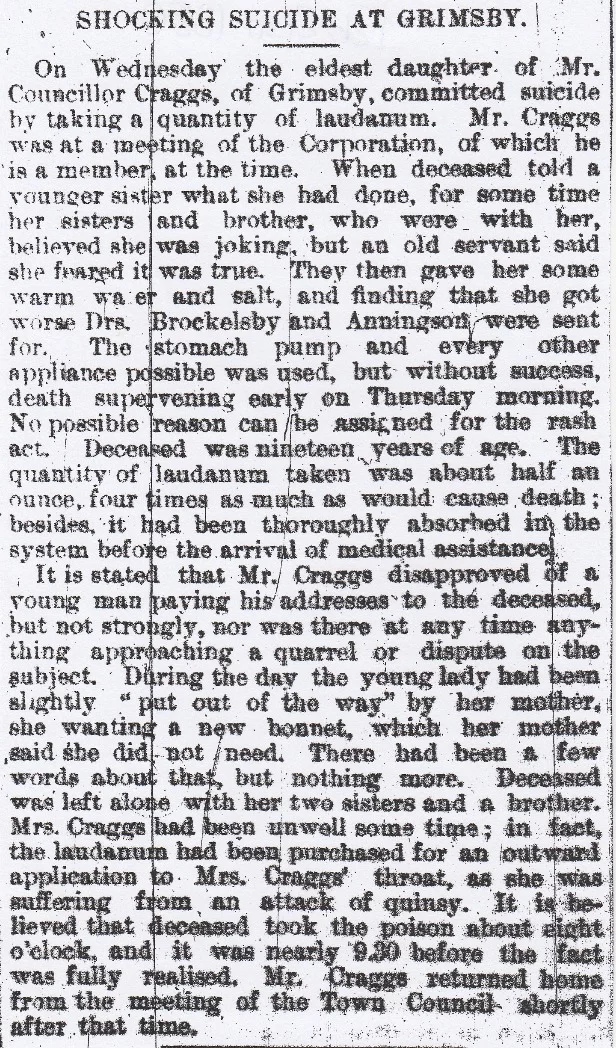
77/ Grimsby, (Attempted Murder/Suicide) December 1895
Henry Gaskill, who was divorced from his wife, saw her in the street one Friday night and attacked her with a knife, stabbing her in the head and hands. He then calmly made his way home and slit his own throat. He is still alive but lies in a precarious condition. (Did he survive?).
78/ Victoria Street (Child Cruelty) December 1896
A five-year-old child named Carter was out playing in Victoria Street when a girl named Ruth Harrington, dragged him into her house and then put a pan on the fire, then pushed it against his skin, burning him severely. The youngster isn’t expected to pull through. Ruth Harrington is said to be not all there. (slightly retarded.)
79/ Grimsby, November 1826 (Steamboat Explosion)
The UK Edinburgh steam packet entered Grimsby due to the appalling weather. After a couple of days in port, the “Graham” steam packet was on her way to Hull, went alongside the Edinburgh. The Graham was on her way when the boiler exploded and Mr John Blow, ironically for his name, was blown to bits. Also killed was John Potton, a labourer, who along with two people that are said to have been killed. The rest of the passengers and crew received serious burns.
The dead are- John Blow, John Potton and Richard Genny, a fruiterer, all blown to smithereens, with no hope of any fragment being found of their bodies. John Cundill was found dead in the water and Wiliam Mellins, a sailor also missing, presumed dead. A child who received third-degree burns has died of her injuries. (Did six die altogether?)
80/ Coke Ovens, Grimsby, (Childs Shocking Death) August 1863

81/ Grimsby, October 1895
Frank William Bartlett was a marine engineer, who had contracted typhoid fever since returning from South America, and was complaining of constant headaches and pains. He told his aunt that he was going mad, and decided to end it all by drinking some carbolic acid.
82/ Grimsby, (Dead Prostitute Abused) December 1863
The most shocking and revolting exhibition of corrupted female humanity recently occurred at Grimsby. The death of an old prostitute named Hill, who kept a brothel in Princess Street, Lower Burgess Street, in which lived ten prostitutes. They tied the dead woman to a chair, put a pipe in her mouth and a glass of gin in her stone-cold hand, then kept asking her what was going on in the place she had gone, while they danced around the corpse. The Reverend W.Hulbert very properly refused to read the entire burial service over the deceased. (No rites due to being a prostitute?)
83/ Corporation Park Suicide, June 1899
Two men were sat next to the lake in Corporation Park at West Marsh, when they heard a gunshot, so they ran to see what was happening. They spotted a body of a male floating in the water. The body was taken out by police and taken to the mortuary. The man was identified as Charles Ernest Otto Kind about 40, a seaman from Berlin. The lake was dragged later on, and the suicide weapon, a revolver, was dragged up from the bottom.
84/ Old Dock/Amelia Terrace, Cemetery Road June 1878

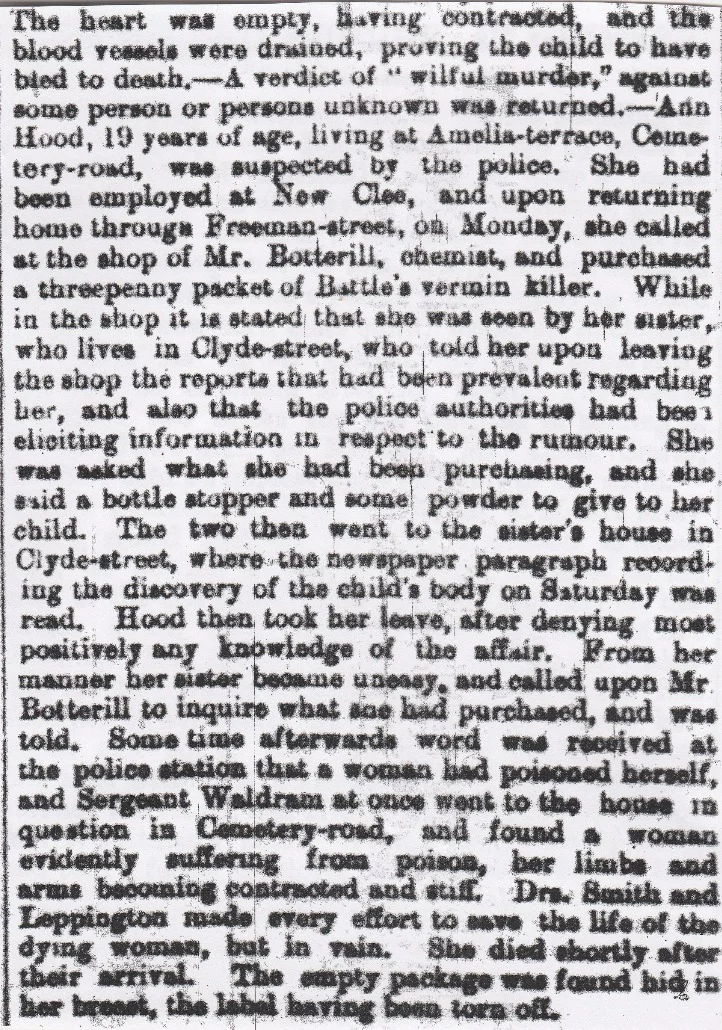
85/ Grimsby Dock Gates, (Two Drowned) April 1891
Two men named Ashmull and Diver were in a boat when it capsized and both men drowned. They were seamen on a fishing smack and were trying to get through the dock gates when it tipped over and they were thrown into the water.
86/ Grimsby (Ex-Mayors Suicide Attempt) October 1893
An ex-mayor of Grimsby, Alderman Dobson, lies in a critical condition in hospital after an attempted suicide. He has been unwell for some time and suffering from depression also and he deemed slitting his throat as the only answer. He was vice chairman of the school board and a leader in Nonconformist circles. In the 1891 Kellys Directory, I found a George Shelton Dobson. Is this the guy?
87/ Strand Street, Grimsby, (Murder) July 1882
Alfred Renney, a fisherman, was stabbed in Strand Street by his girlfriend, Annie Joyce Townsend on June 21st. He has succumbed to his injuries by expiring at Grimsby Hospital. They were sat a the dinner table when an argument erupted and Renney struck out at Townsend, she grabbed a bread-knife in retaliation and plunged it into him several times, in the arm and chest. He managed to stagger to the backyard where he collapsed due to loss of blood. She is now on up on a murder charge.
88/ Messrs Sowerby, Son & Coatsworth, (Warehouse Death) December 1866

89/ Grimsby Fish Dock Basin (Lad Drowns) May 1891
Ten-year-old James Lincoln who lived with his parents at No.55, Guildford Street, fell into the Dock Basin and was drowned. A fisherman who was passing, dived in and tried to save the lad, but was unable and then had to be rescued himself.
90/ King Edward Street North, (Opium Users Suicide) September 1870
The body of German national Carl Fisher, a tailor by trade, killed himself at his lodgings at Mrs Appleby’s in King Edward Street North, by taking some poison. He was a user of opium and smoked it regularly and his manner had become excitable as a result. He hardly had two pennies to rub together but burnt some of his shirts and then sold other clothes, with the money gained going on beer and spirits. He had threatened suicide before. He was found unconscious one morning and never recovered.
91/ Grimsby Docks (Two Lads Drowned) June 1891
Two youngsters drowned in the Docks, in a tragic accident. Eleven-year-old Arthur Pearce was playing on a barge moored off the quay, when he fell into the water. His brother, seventeen-year-old William plunged in after him, then they both got into difficulties and before help could be raised, they had both drowned.
92/ Victoria Street Death, October 1867

93/ “Uronia”/North Sea, January 1907 (Suicide/Superstition)
On New Year’s Eve, while in the North Sea on a fishing trip, the second engineer of the trawler”Uronia”, slit his throat on board the boat. He lingered for a number of hours but finally slipped away. The crew, who were deeply superstitious, refused to go below, with their meals being served in the galley. The “Uronia” was brought back to port and they tried to get a new crew but had great difficulty in scraping them together, due to the suicide on board. (Was it believed to be cursed?)
94/ Grimsby Docks, September 1867
A young lad named Henry White whose parents live in York, was an apprentice to a smack owner, Mr Sellers of Scarborough. He was rowing a boat in the Docks, when it tipped up and he dropped into the water. He was only in there around four minutes, when he sank and drowned.
95/ Grimsby, May 1860 (Boy Killed by Lioness)
The Manders menagerie was in Grimsby and a boy named Redman was swinging on a rope in front of the lion’s den. He was told to pack it in, but he got too close, when a lioness grabbed hold of his head and a lion in the same cage intervened. The keeper came to separate them and she eventually let go of unfortunate chap. His injuries, cuts and lacerations, were so awful that he died as a result.
96/ Grimsby Child Murder, March 1866

97/ Grimsby Skating Disaster (Four Dead) January 1905
Four men drowned in a brick pond near Grimsby when the ice gave way and they fell into the icy cold water. Seven men were skating on the brick pond, when five met in the middle and the weight made the ice crack, then totally crumble. Alfred Hurst was thrown a clothes-line and was rescued. Less fortunate were William Hatfield aged nineteen: Luke Hatfield aged seventeen: Samuel Bury aged thirty and James Thompson aged twenty-one, all from the West Marsh area. The corpses of William Hatfield, Thompson and Bury, were recovered. Luke’s body was found a few hours afterwards. Sadly, Bury was a widower and he leaves a fifteen-month-old child with no father. (What brick pond was this?).
98/ Grimsby Murder/Suicide, February 1913
Fred Wellburn, a twenty-six-year-old wagon repairer was discovered in his father’s house, with severe stab wounds to the throat and chest. His father had attacked him with a butcher’s knife, severing the jugular in the process, then he tried to take his own life by slitting his throat with the same weapon. The father, William Wellburn, is clinging to life and chances are he won’t make it.
99/ Grimsby Manslaughter, October 1888
This clipping shows how useful it was to be a man in Victorian times. Today, hopefully, the sentence this man received would be unthinkable. Thomas Bee, staggered home one night absolutely drunk as a skunk, when an argument erupted between him and his missus. In a moment of madness, he lobbed a paraffin lamp at her, setting her clothes and her alight. Mrs Bee was whisked off to the hospital but died from her burns. 33-year-old Thomas ended up in court at Lincoln on the charge of manslaughter and his sentence was a paltry six months in prison.
100/ Haven Bridge, November 1867 (Caistor Landlord Drowning)

Royal Docks, Grimsby.
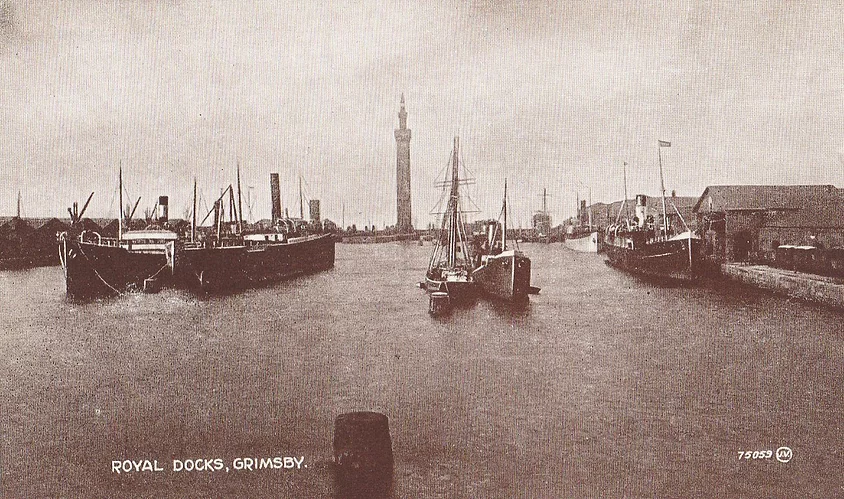
101/ January 1866
One Sunday afternoon some lads were messing about in the timber at the Royal Dock playing hide and seek, when they stumbled across a female corpse. She was identified as a woman named Harrington, alias Minnitt and she renowned as a “woman of loose character”. She had been seen down Cleethorpes Road on Saturday night, not unsurprisingly, with some foreign seamen. It is believed that she had been wandering around here, drunk and then fallen fifteen feet onto the timber, shattering her skull and killing her outright. It was a serious fall, because it describes how her brains were protruding from her head.
102/ September 1885
The lifeless body of 15-year-old Edward Rodwell was fished out of the Royal Dock, Grimsby. He was lodging in King Street and worked on the steam-tug “Honour”. It was while he was on his way to the tug early one morning, when it is thought that he slipped and fell in. The rest of the crew got worried when he didn’t make an appearance, so a couple of men named Flintham and Marshall dragged the Royal Dock and soon after, the body of Rodwell was found.
103/ Royal Dock, Grimsby, (Hull Diver Chokes to Death) November 1881

104/ Royal Docks, Grimsby, (Tug Sinks) March 1915
The Great Central Railway Company’s tug No 7, sank in the Royal Dock at Grimsby, and Pat Kinson the engineer and a boy named Hall, who were both in the engine room at the time, went down with the vessel. The captain and another member of the crew were both rescued. The tug was manoeuvring the paddle steamer “Brighton Queen”, with the cause of the vessels sinking a complete mystery.
105/ Grimsby Docks (Swede Drowns) August 1865
A sailor from a Swedish ship docked in Grimsby, by the name of Jens Peter Gudmunsen, was accidentally drowned in the Docks. Three men were delivering planks of wood onto the quay and Gudmunsen being in the boat, made use of as a sort of bridge from boat to quay. He was missed from the boat and a search was instigated. After twenty minutes his body was discovered at the bottom of the Dock.
106/ Palace Theatre of Varieties Death, (Palace Buffet) November 1907
A claim for compensation against the Palace Theatre of Varieties, better known as the Palace Buffet, (as of 2016, is a branch of Carphone Warehouse) was brought by Mrs Rushbrook, who was killed by the collapse of a drop-curtain he was lowering. She was awarded £150 in July 1907 but the defence team tried to wriggle their way out of paying, by suggesting whether or not Rushbrook was a workman. There was some legal loophole that they got past, to do with manual labour of manual work. He was the latter, so the judge annulled the original verdict. (Anybody explain it better?)
107/ Prince of Wales Theatre Fatality, September 1891

This is an old postcard from my private collection and it shows Freeman Street in the early 1900’s. There is a piece missing, so please don’t copy it, like some people who go E-bay and use the stuff as though it was theirs.
The story is about the superbly named “Una-The Human Fly”, or 16-year-old Sidney Bird from Lowestoft, as his family knew him as. He was doing a trapeze act, which ended in his finale of ceiling walking, with a ladder and suspended rings. He missed his footing during the act and fell head first onto the stage. He was taken backstage and a doctor was summoned, but despite all the assistance and medical help, he died within the hour from a fractured skull. The boy’s father explained that he had been performing that same part of the act since he was eight and never had an accident before this. One slip cost the poor lad his life. “Accidental Death” was the verdict.
108/ Pyewipe Creek (Boy Drowns) June 1859
12-year-old William Dobney had come to stay with relatives in Grimsby, from Hundleby near Spilsby, when they decided to go for a swim at the Pyewipe Creek. Dobney got out of his depth and tried to get to the bank, whereupon his cousin, William, saw him in trouble and tried to grasp hold of him, but they both fell in. The cousin was rescued by a brave chap named Saltfleet and when the body of Dobney was eventually recovered, it was found that life was extinct.
109/ Victoria Street Fatality, (1915) December 1866

An inquest was held the Old King’s Head in Grimsby, touching the death of 32-year-old John Todd, a labourer, also an alcoholic in the pub mentioned. Let me just mention for any Grimbarians reading that the Old King’s Head had the address of 73 Victoria Street and was on the corner of that road and Haven Street. So, John Todd goes into the Old King’s Head and starts downing rum like its going out of fashion, then he had something to eat and then swigged more rum and as result passed out on the floor. A waitress, a Miss Andrews, went to take a look at him to see if he was OK but found no signs of life whatsoever. The verdict was one of “Death from natural causes, accelerated by excessive drinking”, plus they also mentioned that he was supplied with rum, even though he was completely sozzled.
110/ Grimsby (Moisers)Freeman Street December 1915
I saw an advert for Moisers and it’s at 252-256 Freeman Street, the original sewing machine shop. This story is about the son of Walter Moiser, the sewing machine salesman, who was wafting a revolver about when it went off and the bullet entered the boy’s temple. He was taken to Grimsby Hospital but died within a couple of hours of admittance.
111/ Queen Street Suicide, April 1867
Hannah Barker, the wife of William Barker who lived at Queen Street in the town, looks to have been suffering from a severe case of post-natal depression. The two had been taking care of their baby, who was ill with the “frog”? (Anyone know what Frog is?) He left for work at six a.m., then returned at eight a.m., finding the door open. He continued upstairs, where to his horror, he found his wife hanging by a cord, to the bedroom door. She was cut down by neighbours and was found to be dead.
112/ Dock Basin, October 1917 (Boiler Explosion)
Three men were blown to bits in a terrible explosion on board the trawler, King Harald. It was leaving the Docks and had barely got into the Basin, when the boiler suddenly exploded, sending the crew into the water, bar one. There were two engineers below and the steward was in the galley, they were killed on the spot. The “King Harald” sank within a couple of minutes.
113/ River Humber Suicide? July 1876

114/ Grimsby, July 1917 (Baby Show Accident)
At a baby show in Grimsby, an aeroplane had been dropping leaflets from the air and landed in a field nearby. The crowd was anxious to catch a glimpse of the aircraft and hurried to get a look. A second plane was about to land when it swerved to avoid the crowd and it crashed into a hedgerow, knocking down Harriet Simpson, who was taking care of her two-year-old nephew. The child is in a critical condition but Harriet sustained a few cuts and bruises. (Did child make it?/Where was this?)
115/ Old Dock, (Unknown Mans Body) February 1877
Shock Horror! Another body found in Grimsby Docks. This one though was a John Doe. William Johnson said that he arrived in Grimsby five weeks ago, then was employed as a groom at his master’s property. He was known as “George” and he never talked about whether that was his proper name, or where he came from, he was a bit of an enigma. He never turned to feed the horses one day and he was never seen again. When the corpse was discovered, he still had the keys to his master’s stables in his pocket. It was determined that he lived in digs in King Edward Street North, at Charlotte White’s. He gave her the name of Thomas Hudson, or Hutchinson and told her he was from Wisbech in Cambridgeshire. Last time she saw him, he was drunk, but after that, he vanished from the radar. (Was he who he said he was?)
116/ Holme Street Suicide, February 1885
Irishman Patrick McGrail, thirty-five years old and a stonemason by trade, who worked for Riggall and Hewins, builders, killed himself in a shocking manner. He had been lodging at No.4, Holme Street with Mrs Devannah and had been drinking very heavily recently but he had calmed down in the past few days. He became crazy one day when the “shakes” or delirium tremens kicked into his system and he leapt through the glass window one Saturday. He was taken inside but continued to behave strangely and violently and was now in the upstairs portion of the house. A man tried to calm him down, but he flew at him with a poker in his hand telling him that if he didn’t back off he’d kill him. The man then went outside and climbed on the wash-house roof, to see into his room, but McGrail spotted him and then repeated his threats. The man saw sense and went back down. More help turned up and they tried to get into his room, but McGrail was wedged behind the door. When they prized their way in, McGrail was found on the floor with blood seeping from his throat from a self-inflicted wound with a pen-knife. He ended up with him dying shortly afterwards.
117/ Rose and Crown Manslaughter (Victoria Street) July 1881


118/ Grimsby (Manslaughter On Board Trawler) August 1914
Able seaman Thomas Henry Hogg aged twenty-three was accidentally shot by Henry George Warren on board a vessel in the North Sea. The crew were all in the mess-room when Warren gave the order for the men to get to work, or “turn to” as it commonly referred to. They all dithered about and didn’t look too keen on starting the day’s work, so he grabbed one of the four revolvers that were kept on board and turned around. The gun went off and the bullet went straight through Hogg’s head, killing him instantly. Warren claimed later that he had no idea that it was loaded. The gun didn’t even belong to anybody in particular. The verdict was one of “Accidental Death”.
119/ Flamborough/Grimsby (Skipper Cruelty) August 1873
The story here gives a detailed account of how brutal some of the skippers were to other crew members and used to beat them on a regular basis. Frederick Donker was an apprentice from London and was the cook on board the “Jubilee”. The skipper, William Brusey struck him with a stick a number of times and this caused the probable suicide of Donker, because he then jumped overboard into the North Sea near the Flamborough coast. Another similar case was that of, Frederick Brewer, who was an apprentice from the Dover Union, on the smack “Wilberforce” and when he was beaten and physically abused, he could take no more and jumped overboard. The skipper Joshua Hudson would thrash him with a rope’s end.
Back to Brusey. He was arrested for manslaughter and the Grand jury ignored this plea but found him guilty of assault. The judge said that he didn’t think the beating of the deceased led him to kill himself and Brusey was discharged.
120/ Grimsby Losses in 1915.
From January 1s,t 1915 to mid-December of 1915, the Grimsby fleet lost a total of fifty=five trawlers, losing a total of 269 lives. The average cost of each trawler is £4000.
121/ Littlefield Lane Suicide, May 1882

122/ West Fitties Drowning, July 1881
Ethelbert Johnson aged twelve, the son of Charles Johnson, a labourer residing in New Dock Street, was tragically drowned while bathing at a brick-pond near the West Fitties. A woman thought he was messing about in the water, not screaming for help and trying to stay afloat. A lad called Webber from 116, Albert Street, dived in to save him and grabbed his hair and started to bring him to the bank. His body was limp and lifeless and mouth to mouth resuscitation was tried on him, but to no avail. The verdict of “Accidental Drowning” was returned.
123/ H.T.Hart and Co, Victoria Street, (Boss’s Suicide) June 1908
Harry Thornton Hart, the boss at the drapery shop, H.T.Hart and Co. in Victoria Street was discovered by an employee, Mr Harling, sat in a chair in his private sitting-room with a bullet wound to the temple. In his hand was the suicide weapon. Results of the post-mortem showed that he had been dead for a number of hours. He also left a couple of letters, one to his sister and the other to the female cashier in the shop. He was only thirty-eight years of age.
124/ Alexandra Dock Suicide, June 1906
Kate Loftus was the wife of a marine engineer who had left her for another woman, with whom he had previously co-habited, after being married for only a few months. After seeing the couple together, Kate deteriorated and she used to regularly go and cry on her sister’s shoulder. She would shake from time to time and had mentioned to her sister that “This will kill me”. She woke her one night and said “He’s coming home, he’ll be in this tide”, which meant he was coming back from a fishing trip. The following morning, she was a bag of nerves and she went out. She simply vanished after that and was found in the Alexandra Dock the next day. Her premonition of her ex-husband coming back was entirely accurate as well.
125/ River Freshney?/Ship Inn (Flottergate) July 1867

126/ Holme Hill Brickyard (Welholme/Convamore/Heneage Road) January 1879
This is partially explained, by the fact that everyone who talked about this woman during the inquiry, said that she was drunk when they saw her. Sarah Ann Lee aged thirty-four, the wife of Henry Lee and residing in Macaulay Street, was found in a couple of feet of water in the Holme Hill brickyard, which is a piece of waste ground nowadays, behind the roads of Welholme, Convamore and Heneage. She had wounds on her shins, suggesting that she stumbled or fell on some bricks or stumps left in the ground. A sexton named William Topliss found the body. A witness said she called at their house that evening and said she appeared to have been drinking.The verdict was “Found Drowned, but there was no evidence to show how she got in the water”.
127/ Clarence Terrace Suicide, (Abbey Road area) February 1880
Auctioneer Mark Dawson was found in the water-closet of his home at Clarence Terrace, around the Abbey Road area nowadays, with his throat slit from ear to ear. His wife was away from home at the time and the others had gone to a local chapel at George Street. His son found a letter in the house, written by his father and saying that he had deceived his wife, and basically, that he had lost some money on the speculations he had put money on, and that by the time he read the letter he would have killed himself. The son got a friend of his to come over and it was when they searched the place, he was discovered covered in blood in the W.C., with a razor by his side and a knife on the toilet seat. The note he left was read out at the inquiry, it read:
“My brain is racked this morning. I have deceived you all. I cannot bear it any longer; may God have mercy upon me. You will find my body in the water-closet upstairs- M.D”.
128/ Albert Street May 1888
Not unusually, there is drink involved in this awful story of, what can only be described as manslaughter. Charles Darnell of Albert Street, just off Freeman Street, was a 47-year-old labourer, in need of a housekeeper. Along comes 56-year-old Barbara Withers and she gets the job of his general housekeeper. One day, Darnell had some friends of his come to the house and start a drinking binge, which continued on to the Prince of Wales pub (On the corner of Freeman Street and Church Street, I think!). Darnell came in drunk and demanded his supper, which Withers was supposed to have on the table. She too liked a wee dram and with two drunkards arguing with each other, the worst was likely to happen and Darnell kicked her in the stomach. She went down, dreadfully injured and later on died of acute peritonitis. Darnell was mortified but he was found guilty of causing the death of Barbara Withers and got seven years penal servitude (Hard labour).
129/ Grimsby Railway Station, September 1878


130/ Maude Street/Flottergate Fatality, March 1885
Judith Sergeant aged sixty-three, died from injuries caused by falling from a cart at Maude Street. She and her husband were on their way back to Marshchapel, when deceased said she wanted to get off for something. In doing so, her dress caught on a piece of iron on the step and threw her down. Help was swift and she was taken to a house nearby, where she remained until she died. A witness said that when she fell, he talked to her but got no answer as she was knocked unconscious. “Accidental death” was the verdict, having suffered concussion of the brain.
